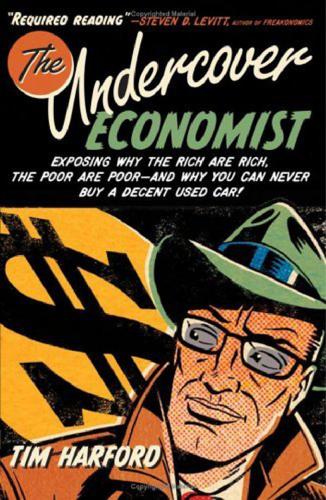
The Undercover Economist: Exposing Why the Rich Are Rich, the Poor Are Poor, and Why You Can Never Buy a Decent Used Car
by
Tim Harford
Published 15 Mar 2006
The two members of the audience, put on the spot, were quite unable to work out what the optimal strategy was for bidding in the auction. The difficulty—which is a challenge for bidders in many auctions, including spectrum auctions—is that the two victims just didn’t know the value of what they were bidding for. They knew part of the value, of course, because they knew how much money had been in their own wallet. But each knew nothing about the contents of the other’s wallet. In a spectrum auction, the prob- • 162 • T H E M E N W H O K N E W T H E V A L U E O F N O T H I N G lem is similar: each bidder has his own forecasts and technology plans, but each knows that other bidders will probably have different insights.
…
Union of Needletrades, Industrial, Vehicle Excise Duties, 82 and Textile Employees vehicle taxes, 82–83 (UNITE), 224 Ven der Beurs family, 201–2 unions, 25–26, 224–25 Venezuela, 23 United Kingdom Venkatesh, Sudhir, 24 air pollution, 81 Vickrey auctions, 164 efficiency vs. fairness, 73 Vietnam, 228–29 fuel prices, 88 village enterprises, 244 health care system, 28, 120, 121, viruses, 184 122, 126, 132 Visudyne, 127, 133 immigration, 28 Vodafone, 173, 174 industrial revolution, 233 Voluntary Service Overseas (VSO), infrastructure, 183 190 railroads, 151 Von Neumann, John, 156, 158, 161– spectrum auctions, 163, 165–68, 62, 167, 175 168–73, 173–75 vouchers, 90 taxation, 82 unions, 26 wages, 24–26, 67, 94 wealth inequality, 89 The Wall Street Crash—And After United States (Fisher), 148–49 exports, 245 Wal-Mart, 26 fuel prices, 88 waste, 192, 233 health care system, 113, 119–23, Waterloo station, 6 122 wealth and wealth inequality industrial revolution, 233 in China, 233, 252 infrastructure, 183 and development, 197–98 pollution, 81, 221 and fairness, 75 and special interests, 227 and nonmarket economies, 69 spectrum rights auctions, 159–61, and price sensitivity, 38 165 and taxation, 71–72 taxation, 82 in the US and UK, 89 • 275 • I N D E X West End, London, 17 world economy, 199 Western Europe, 213 World War II, 73 Western society, 68 Wholefoods, 42, 43–44, 114–15 xenophobia, 212 Why Globalization Works (Wolf), 251 Xi’an, China, 245 Wilde, Oscar, 155 Yahoo!
…
From here on everything is a bonus; maybe you’ll get $310,000, or $320,000, or even $350,000. Who knows? Then the price keeps going up. It hits $320,000. It reaches $350,000. $400,000. $500,000. What’s happening? You can scarcely believe it. This unexpected turn of events is similar to what happened in the UK spectrum auction, except the stakes were ten thousand times higher: not £300,000 but £3 billion. For a week, the bidding went smoothly; the rules about continuous bidding kept the total revenue rising steadily. After about twenty-five rounds of bidding, bidders were committed to around £400 million for each license.
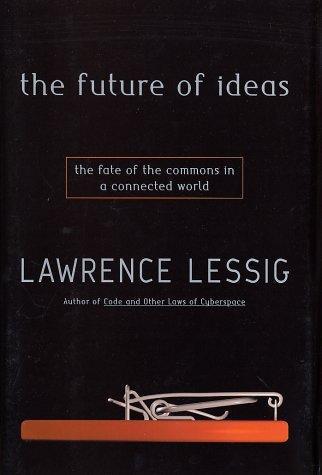
The Future of Ideas: The Fate of the Commons in a Connected World
by
Lawrence Lessig
Published 14 Jul 2001
.): Hazlett has cataloged the cases where favored interests have succeeded in using their power over regulators to resist new technologies;2 as Noam writes, “[I]n the early 1950s, only newspaper companies that had editorially endorsed Eisenhower for President had a chance at getting a TV license.”3 In the third era (now), the right to use spectrum is increasingly allocated through auctions. The government sells the right to the highest bidder (subject to a scad of typically governmentlike, mainly silly, conditions). That bidder uses the spectrum as the auction specifies or, in a small set of cases, the bidder is then free to reassign the right to others. Politicians from the Left and the Right just love auctions. For the Left, auctions promise more money for the government to spend; for the Right, auctions sound like markets, and markets are always good.
…
Huber is a brilliant polymath who, while working full-time as a lawyer, has written some of the most important policy and academic work about government regulation in general and telecommunications policy in particular.31 In his book Law and Disorder in Cyberspace, Huber describes both the market model for allocating spectrum—where spectrum rights are auctioned off up front—and the commons model for allocating spectrum, promoted most strongly by an ally of Huber's, George Gilder. As I described in chapter 5, Gilder argues strongly that we should allocate spectrum as a commons. Auctions, Gilder argues, will simply entrench existing uses; free or common spectrum would create a strong incentive for new uses. Huber does not reject Gilder's predications. He argues instead that we could get to Gilder's world of spectrum as a commons by first auctioning off all the spectrum and then allowing the market to “reassemble” the rights if that proves efficient.
…
All agree that the alternative of allowing spectrum to be sold is like “having the old AT&T auction off the right to compete against itself.” Noam, “Beyond Spectrum Auctions,” 473. Noam and Benkler have an even stronger (from a legal perspective) argument against the sale of spectrum. In a world where the control of spectrum was not “necessary,” as the Supreme Court said it was in the NBC case, why was control of spectrum constitutionally permitted? Spectrum is speech, and the regulation of spectrum is the regulation of speech. The constitutional status of spectrum auctions is rendered problematic by the emergence of this alternative technology. Control is not “necessary” anymore, any more than control of newspapers is necessary.
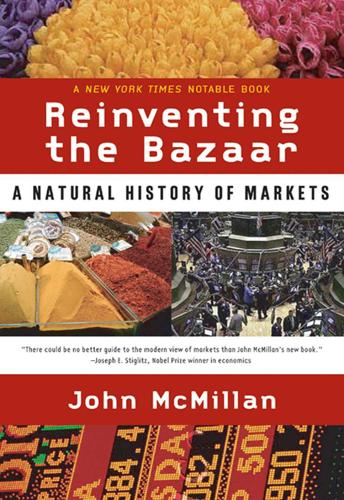
Reinventing the Bazaar: A Natural History of Markets
by
John McMillan
Published 1 Jan 2002
In terms of the money it raised and the information it revealed about the spectrum’s true value, the auction was a success. What is the government’s role in spectrum allocation now that auctioning is used? It still has its regulatory function, parceling up the spectrum and coordinating its usage. Without a clear definition of property rights, the spectrum, like anything else, would not be used efficiently. What was turned over to the market was the decision—hard for a government official to make well—of who gets the right to use each piece of spectrum. The main beneficiaries of the spectrum auctions were consumers, who got a speedy introduction of new telecommunication services at competitive prices, and taxpayers, through the revenue generated.
…
“Back at headquarters, people were crunching the numbers.” The auction went on for a week, raising $617 million for ten licenses covering a tiny sliver of spectrum. Several more auctions were subsequently held, for larger chunks of spectrum to be used for mobile telephones, portable fax machines, and wireless computer networks. After the trial run in the Washington hotel, the FCC ran the auctions electronically. As of early 2001 they had fetched a total of $42 billion. A new market was created with the spectrum auctions. Previously, the government had given the spectrum rights to telephone and broadcasting companies. Initially, licenses were assigned by administrative decision.
…
Every day, thousands of similar scenes recur at internet auction sites—except with a computer program acting as the auctioneer. During the brief history of electronic auctions, from 1994, markets have been created in front of us as entrepreneurs have devised new ways of transacting. The public sector also has turned to using auctions to allocate publicly owned resources like the electromagnetic spectrum. These novel auctions raise some knotty design problems. Economic theory helps us understand how they work, and is being used in designing further new selling mechanisms. Many transactions, such as in a supermarket or a department store, take place at prices fixed by the seller. An auction, by contrast, is interactive: the seller puts the pricing in the hands of the potential buyers and relies on the competition among them to get an acceptable price.
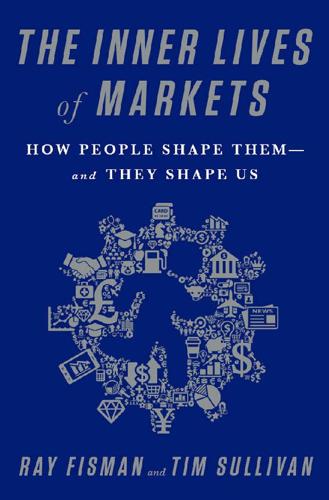
The Inner Lives of Markets: How People Shape Them—And They Shape Us
by
Tim Sullivan
Published 6 Jun 2016
It’s important to appreciate how big a break this represents from how things used to be done, when there was a standard toolkit that sellers, whether private or public, used to unload their goods. And within the narrow set of options available, it’s not even clear how much thought went into the decision of whether to use, say, a lottery or an English auction. One oft-cited example of auction theory’s triumph is the wireless spectrum auction of 1995. Previously, the Federal Communications Commission had in fact relied on a lottery: you applied for a cellular license in a particular locale, and if your number came up, you were the proud owner of spectrum somewhere in America. This might have been fair, since everyone had the same shot at getting each license, but it didn’t generate much revenue for the government.
…
The lottery might leave a spectrum owner with licenses in, say, Albuquerque and Albany, and he’d then have to find some way of swapping his Albany license for one in Santa Fe. (It also created a boon for Washington law firms that created “phone companies” for the sole purpose of bidding on licenses.17) When the FCC opened up the process to proposals from auction theorists, the resulting spectrum auction in 1995 involved a book-length set of rules describing the various contingencies and stipulations of participating in the spectrum sale. But the complications generated a big payday for Uncle Sam. The auction mechanism that Stanford economists Paul Milgrom and Robert Wilson proposed generated revenues of more than $7 billion.
…
The way you regulate payment cards has nothing to do with the way that you regulate intellectual property or railroads. . . . It’s not a one line thing.”12 Tirole also embodies the increasing incursion of economic theory into the functioning of markets economists study as they find themselves advising Silicon Valley companies and designing government health-care exchanges and spectrum auctions. Despite his low profile, Tirole’s advice is much sought after by the companies that are the object of his study: it’s of immense value to businesspeople to talk with someone who can strip a complicated situation down to its bare essentials, whether expressed in algebra or prose. The dense mathematics of his academic papers has served as a basis for regulatory policies on telecommunication networks.

Cogs and Monsters: What Economics Is, and What It Should Be
by
Diane Coyle
Published 11 Oct 2021
There are very many more examples. Clever economics in designing and implementing an auction of 3G spectrum rights to telecommunications companies netted the UK government £22.5bn in a 2000 auction, about 2.5 percent of GDP at the time (Binmore and Klemperer 2002). The US Federal Communications Commission has been running spectrum auctions since the mid-1990s, raising tens of billions of dollars. Across areas of social and economic policy such as education, health care, welfare benefits, housing, pensions, applied economic analysis is the everyday bread and butter of public policy, in Whitehall, Washington, Brussels, and other capitals, in industry regulators, in some think tanks, and in the academic world.
…
The standard assumption is that the players choose rationally: they will calculate what is in their best interests, given their assumption that everyone else will do the same. This is the Nash equilibrium concept. Nobody can do any better by taking a different course of action. Game theory has been successfully applied in practical contexts ranging from business strategy to spectrum auctions, with excellent results. Ariel Rubinstein has experimented with specific games, or strategic contests, with his students, audiences at his lectures, and respondents to his website surveys, collecting more than 13,000 responses altogether. His conclusion is that people do not behave in life as they are assumed to do in game-theoretic models.
…
J., 122, 124 BBC Reith Lectures, 77–78 BBC Trust, 83 Becker, Gary, 2, 92, 119 behavioural economics: aggregation and, 3, 40, 42, 71–72, 100–102, 106, 113, 122–23, 141, 176–77, 201–2; beliefs of tomorrow and, 22; bias and, 109, 136; Coase on, 58; cognitive science and, 35–36, 48, 51, 91–92, 118–19, 186; competition and, 45–51 (see also competition); consumers and, 22, 59–60, 92, 109; context and, 88; failures and, 55; Goodhart’s Law and, 72, 103; happiness and, 70–71, 153; incentives and, 29, 33, 35, 55, 63–64, 80, 106, 110, 160, 200; interventions and, 48, 63, 104, 106, 160, 208, 211; markets as process and, 37–45; models and, 22, 35, 47, 63, 88, 92–93, 119, 136, 154; outsider context and, 88, 92–93, 100, 103–9; performativity and, 11, 23, 30, 211; progress and, 136–37, 145, 154, 157–60; psychology and, 38, 63, 70, 92, 94; public choice theory and, 64, 106, 119, 124; public services and, 33; rationality and, 22, 35, 46–47, 59, 109, 117–19; self-referential policy advice and, 63–64; separation protocol and, 119–20, 124; special interest groups and, 64–66; technocratic dilemma and, 67–79; twenty-first-century policy and, 186, 202, 207–8; Wu study and, 8 Bell, Daniel, 67 Bernanke, Ben, 17 Berners-Lee, Tim, 195 bias: academics and, 6; artificial intelligence (AI) and, 13, 161, 165, 187; behavioural, 109, 136; causality and, 13, 105; control groups and, 105; data, 13, 101, 105, 161, 187, 209; decision making and, 13, 109, 187, 209; framing effects and, 47; gender, 6, 8; institutional, 180; market, 180, 187, 209; non-rational, 47, 109; skill-biased technical change and, 132; special interest groups and, 64–66; survey, 101; twenty-first-century policy and, 187, 209 Biden, Joe, 205 Big Bang, 16 big data, 3, 13, 40, 51, 86, 100, 203, 209 biodiversity, 39, 63, 165 Black, Fisher, 23–25, 28 blackboard economies, 99 black box solutions, 161 BlackLivesMatter, 9, 214 black markets, 43 Black-Scholes-Merton model, 24–25 Blair, Tony, 208 Blake, William, 150 Blue Books, 150 BMW, 196 Booking, 173 Borges, J., 90 Boskin Commission, 146–47 Boston Dynamics, 137 Bowles, Sam, 85, 117, 119 Bretton Woods, 192 Brexit, 1, 37, 53, 56, 70, 110, 131, 155, 213 Brown, Dan, 108 Brynjolfsson, Eric, 176 bubbles, 20, 22, 29 Buchanan, James, 33 budget constraints, 177 Bundeskartellamt, 205 Bureau of Economic Policy Analysis, 66 business cycles, 71, 81, 102, 124 calculus, 16, 33, 90, 145 Calculus of Consent, The: Logical Foundations of Constitutional Democracy (Buchanan and Tullock), 33 Camus, Albert, 87, 108, 111 capitalism: criticism of, 19–20; free market and, 19, 41, 186; globalisation and, 110, 132, 139, 154, 164, 193–94, 196, 213; inequality from, 19; progress and, 143, 149; Schumpeter on, 143; twenty-first-century policy and, 186, 190, 195 Capital (Piketty), 131 carbon emissions, 38–40, 180, 187 Carlin, Wendy, 85 Cartlidge, John, 27 Case, Anne, 131 cash for clunkers, 55, 63 causality: bias and, 13, 105; correlation and, 94; deductive approach and, 103; economically establishing, 100; empirical work and, 2, 61, 94–96, 99; feedback and, 11, 94, 96; Leamer on, 102; methodological debate over, 2; models and, 2, 94–95, 102; moral issues and, 96; outsider context and, 94–96, 99–105; progress and, 137; public responsibilities and, 61, 74; randomised control trials (RCTs) and, 93–95, 105, 109–10; reflexivity and, 11, 81; societal statistics and, 61; statistics and, 61, 95, 99, 102; two-way, 94, 96 central banks: independence of, 16; progress and, 149; public responsibilities and, 16, 32, 62, 64, 66–67, 76, 81 central planning: artificial intelligence (AI) and, 184, 186–87; competition and, 38, 41, 124, 182; failure of communist, 40, 182–88, 190; socialist calculation debate and, 182–88, 190, 209 Central Planning Bureau, 66 Chetty, Raj, 86 Chicago School, 24–25, 73, 75, 190, 193–94 Chile, 184 China, 173, 195, 206 Citadel, 27 City of London, 16, 19 climate change, 85, 148, 154 Close the Door campaign, 155–56 cloud computing, 150, 170–72, 184, 197 Coase, Ronald, 57–58, 62, 98–99 codes of conduct, 9, 206 cognitive science, 35–36, 48, 51, 91–92, 118–19, 186 Colander, David, 100 Cold War, 190 Coming of Post-Industrial Society, The (Bell), 67 common sense, 78, 127 communication, 53, 127, 168; bandwidth and, 171; compression and, 171; cost of, 196; 4G platforms and, 195; instant messaging, 171; latency and, 171; price of, 150, 171, 177; servers and, 25–26, 141, 170; smartphones and, 46, 138–39, 164, 171, 173, 177, 195, 198; SMS, 171; social media and, 52, 73, 82, 140–41, 149, 157, 163, 173, 176–77, 195; telephony and, 4, 31, 46, 98, 123, 138–39, 144, 156, 164, 171, 173–74, 177, 184, 195, 198; 3G platforms, 60, 139, 173, 195; transmission speeds and, 171 comparative advantage, 78, 97 competition: behavioural fix and, 45–51; central planning and, 38, 41, 124, 182; Chinese, 173, 195, 206; creative destruction and, 41; digital economy and, 42, 85, 165, 181, 201–6; directory numbers and, 60; empirical work and, 181, 209; envelopment and, 203–4; incumbents and, 41–42; innovation and, 28, 41, 46, 68, 85, 209; monopolies and, 20, 42; network effects and, 202, 205; opportunity cost and, 56, 58, 80, 156; outsider context and, 98, 105; Pareto criterion and, 122–23, 126–27, 129; production and, 12, 41; profit and, 33, 41–42, 105, 204; progress and, 135, 158, 165; public responsibilities and, 28, 33, 38, 41–42, 45–48, 57–69, 74, 77, 79, 85; rationality and, 117; resource, 41, 45, 117, 123, 125; separation protocol and, 120, 123–25; socialist calculation debate and, 182–83; special interest groups and, 64–66; specific studies in, 12; spectrum auctions and, 60–61; SSNIP test and, 204; twenty-first-century policy and, 182, 201–9 Competition and Markets Authority (CMA), 205 computers: AI and, 116 (see also artificial intelligence [AI]); Black-Scholes-Merton model and, 24–25; changing technology and, 169; cloud computing and, 150, 170–72, 184, 197; data sets and, 2, 13, 51–52, 60, 101, 161, 177, 201, 209; David on, 169; declining price of, 170; empirical work and, 2, 17, 52; exchange locations and, 25; feedback and, 179; Millennium Bug and, 155; Moore’s Law and, 170, 184; power of, 2, 17, 40, 58, 170, 183–84, 188; progress and, 138, 144, 155; rationality and, 116–17; servers and, 25–26, 141, 170; software and, 25, 140, 155, 171, 177–78, 186, 197, 200–201, 203; Solow on, 169; speed and, 25, 184; statistics and, 17, 52, 58, 144, 169; supercomputers, 170; twenty-first-century policy and, 183–84, 186, 188, 214; ultra-high frequency trading (HFT) and, 25–27 conservatism, 30 Consumer Price Index (CPI), 146–47, 172 consumers: bad choices and, 3; behavioural economics and, 22, 59–60, 92, 109; conspicuous consumption and, 42; digital economy and, 42, 137, 172–76, 181, 198, 200–206, 213; empirical work and, 3, 181; income and, 93 (see also income); innovation and, 28, 102, 200; Keynes and, 22; online shopping and, 173, 198; outsider context and, 92, 96, 98, 100–102, 105, 108–9; progress and, 137, 141, 144, 146–47, 151; public responsibilities and, 22, 28, 42, 59–60, 65; rationality and, 116; technology and, 28, 102, 171–76, 181, 200, 213; time spent online, 176–78; twenty-first-century policy and, 184, 198–206; welfare and, 105, 206 Cook, Eli, 150 copyright, 140 CORE’s The Economy, 85–86, 212–13 cost-benefit analysis (CBA), 56–57, 58n12, 125–26, 207 cost of living, 143–47, 172 counterfactuals, 97–98, 158, 161, 198, 208 Covid19 pandemic: body politics and, 163; financial recovery from, 88, 114; GDP growth and, 88, 165; impact of, 3, 10–11, 14, 20, 38, 43, 45, 68, 75, 88, 110, 114, 132–33, 149, 153, 155, 163–66, 181, 194, 213–15; lockdowns and, 3, 43, 45, 88, 114, 163, 198; public opinion and, 165–66 “Creating Humble Economists” (Colander), 100 creative destruction, 41 curriculum issues, 2, 4–5, 83, 85, 88 Daily Telegraph, 159 Darwin, Charles, 48 data centres, 26 data sets, 2, 13, 51–52, 60, 101, 161, 177, 201, 209 David, Paul, 169 Deaths of Despair (Case and Deaton), 131 Deaton, Angus, 128–29, 131 debt, 76, 101, 153 decision making: artificial intelligence (AI) and, 116, 186–87; bias and, 13, 109, 187, 209; Green Book and, 56, 126; normative economics and, 110, 114, 120; opportunity cost and, 56; outsider context and, 93; production and, 12, 123, 140, 196; progress and, 160, 162; rationality and, 116 (see also rationality); rules of thumb and, 47–48, 90, 117, 212; self knowledge and, 81; separation protocol and, 120 DeepMind, 115–16 Deliveroo, 173 demand management, 31, 191–92 democracy, 33, 67, 69, 79, 193 deregulation, 16, 31, 60, 68, 71, 193–94 derivative markets, 16, 18, 23–25, 28 Desrosières, Alain, 146 Dickens, Charles, 150 digital economy: AI and, 115 (see also artificial intelligence (AI)); changing nature of, 168–81; cloud computing and, 150, 170–72, 184, 197; cogs and, 6, 129, 154, 165, 179; competition and, 42, 85, 165, 181, 201–6; consumers and, 42, 137, 172–76, 181, 198, 200–206, 213; difference of, 168–76; dominance of by giant companies, 133; envelopment and, 203–4; 4G platforms, 195; GAFAM and, 173; globalisation and, 110, 132, 139, 154, 164, 193–96, 213; GPTs and, 169; Great Financial Crisis (GFC) and, 113–14; growth and, 129, 132, 140, 143, 194, 202; implications of, 176–78, 211–14; individual and, 6, 13–14, 128–29, 141, 175, 179, 181, 201; innovation and, 169–70; market changes and, 173–76; measuring online value and, 176; monsters and, 6, 154; network effects and, 127, 141, 174, 177, 185, 199–202, 205, 209; new agenda for, 179–81; online shopping and, 173, 198; Phillips machine and, 135–37, 151, 192; populism and, 211; production and, 132, 140, 142, 176, 195–97, 202, 213; progress and, 14, 137–43, 150, 153–54, 164–67; Project CyberSyn and, 184; services and, 176; software and, 25, 140, 155, 171, 177–78, 186, 197, 200–201, 203; statistics and, 113, 150, 164, 170, 172, 212; superstar features and, 173–74; 3G platforms, 60, 139, 173, 195; twenty-first-century policy and, 13, 185–88, 194–210; wealth creation and, 132–33; welfare and, 128, 134, 143, 206, 208, 212 Director, Aaron, 190 directory numbers, 60 discount rates, 147–48 diversity, 6–9, 213–14 Dow Jones, 26 Duflo, Esther, 20–21, 52, 109, 137 eBay, 175 ECO, 11 Economics Job Market Rumors, 8 Economics Observatory (ECO), 214 economies of scale: changing technology and, 174; network effects and, 127, 174, 177, 185, 199–201, 209; progress and, 142 education: derivatives and, 16; growth and, 16–17, 132; interventions and, 12; online, 177; policy on, 60; provision of basic, 30; real-world context and, 88; skills and, 88, 128, 132, 169–70; spread of higher, 151, 153 Efficient Markets Hypothesis, 17, 29 Eichengreen, Barry, 16 electricity: changing economies and, 127, 169, 191–92; progress and, 139, 142, 156, 165, 169, 191–92; regulation and, 65; supply of, 32; twenty-first-century policy and, 191–92, 200–201; warranties on goods and, 105 empirical work: behavioural economics and, 117, 159; causality and, 2, 61, 94–96, 99; competition and, 181, 209; computers and, 2, 17, 52; consumers and, 3, 181; context and, 17, 35, 61, 78, 92; correlation and, 70, 94; counterfactuals and, 97–98, 158, 161, 198, 208; data sets and, 2, 13, 51–52, 60, 101, 161, 177, 201, 209; feedback and, 11, 94–95, 155, 179, 188–89, 203, 205; growth and, 17, 61, 78, 209; macroeconomics and, 74, 100; market structures and, 35; physics envy and, 50; politics and, 3, 76, 78–79, 124, 213; populism and, 77; public responsibilities and, 17, 35, 40, 52, 61, 70, 74–81, 90, 92, 94–102, 110–11; randomised control trials (RCTs) and, 93–95, 105, 109–10; rationality and, 17; separation protocol and, 119, 124, 128; social constructs and, 13; statistics and, 17, 52, 61, 90, 95, 99; taxes and, 3; theory and, 2, 17, 52, 74, 90, 96, 99, 124, 181 endogenous growth theory, 17, 202 Enlightenment, 20 envelopment, 203–4 environmentalists, 126 equilibrium, 31, 38–39, 90–91, 123, 182 ethics, 4, 34, 39, 100, 105, 115, 119–24 Ethics and Society group, 115 ethnicity, 6–7, 9 European Commission, 67, 130, 205 European Steel and Coal Community, 190 European Union (EU), 37, 67, 195, 204 Eurozone, 67, 74 exchange rates, 118, 192 Facebook, 133, 173, 204–5 facial recognition, 165 fairness, 43, 45–46, 166 fake items, 98 Fear Index, The (Harris), 27 feedback: causality and, 11, 94–96; changing technology and, 179; political economy and, 188–89; progress and, 155; twenty-first-century policy and, 203, 205 financial intermediation services indirectly measured (FISIM), 28 Financial Times, 68–69, 97–98 Fisher Ideal index, 144n3 fixed costs, 174, 177, 179, 185–86, 200 forecasting: agent-based modeling and, 102; conditional projections and, 76; financial crises and, 17, 30, 100–101, 112–13; growth and, 37, 61; inflation and, 36; macroeconomics and, 3, 12, 36–37, 76, 101–2, 112; models and, 17, 74, 101–2, 113; self-fulfilling prophecies and, 5, 22–23, 154–55, 157; twenty-first-century policy and, 205; weather, 76 Fourastié, J., 191 4G platforms, 195 framing, 47, 130, 208 Frankenfinance, 18, 21, 25, 51–52, 165 Freakonomics, 108 free market: Brexit and, 213; capitalism and, 19, 41, 186; criticism of, 19; globalisation and, 110, 132, 139, 154, 164, 193–94, 196, 213; politics and, 30, 36, 130, 206; public responsibilities and, 19, 30–32, 35–36, 45, 54; separation protocol and, 123–24; twenty-first-century policy and, 182, 186, 191, 193, 195, 207 frictions, 22, 113, 136, 154, 182 Friedman, Ben, 16 Friedman, Milton, 16, 31, 93, 104, 121, 190 Furman, Jason, 86 GAFAM, 173 GameStop, 27 game theory, 48, 90–91, 129, 159–60, 179–80 Gelman, Andrew, 108 gender, 6–9, 93 GenZ, 166 Giavazzi, Francesco, 68 Gigerenzer, Gerd, 48 Gilded Age, 133 Giudici, Claudio, 69 Glaeser, Ed, 92 globalisation, 110, 132, 139, 154, 164, 193–96, 213 Goldman Sachs, 19 Good Economics for Hard Times (Banerjee and Duflo), 109 Goodhart’s Law, 72, 103 Google, 133, 141, 173, 201, 204–5 Gordon, Robert, 142 Gould, Stephen Jay, 49–50 Gove, Michael, 110, 149 Government Economic Service (GES), 53, 83–85 GPT, 169 Great Depression, 3, 10, 17, 20, 74, 191, 213 Great Financial Crisis (GFC): behavioural economics and, 51; consequences of, 1, 3, 11, 213; digital economy and, 113–14; dynamic stochastic general equilibrium models and, 31; forecasting, 30, 101, 112–13; Greece and, 56–58, 67; Italy and, 56–58, 67–69; models and, 31, 101, 113; outsider context and, 87–88, 101, 110, 112–14; progress and, 149, 153, 159; public responsibilities and, 16–19, 21, 29–31, 37–38, 50–51, 56, 67–68, 73–74, 79, 84; technology and, 56, 181; twenty-first-century policy and, 194 Great Moderation, 17, 73 Greece, 56, 67–68 greed, 11, 16, 29, 164 Green, Duncan, 95–96 Green Book, 56, 126 Greenspan, Alan, 101 Griliches, Zvi, 198 Gross Domestic Product (GDP), 60; Covid19 pandemic and, 88, 165; Fisher Ideal index and, 144n3; FISIM and, 28; flatlining of, 142; free market and, 130; Gross Domestic Product (GDP) and, 172–73; Gross National Product (GNP) and, 151; growth and, 28, 46, 88, 97, 138, 143–44, 159, 165, 169, 171–72; inflation and, 13, 113, 148; internet and, 97; Laspeyres index and, 144n3; macroeconomics and, 13, 101, 113, 151; progress and, 138, 142–44, 148, 151, 158–59, 165, 172–73; real, 101, 142–44, 169, 173; Sen-Stiglitz-Fitoussi Commission on the Measurement of Economic Performance and, 151; social welfare and, 134; twenty-first-century policy and, 187; Winter of Discontent and, 158, 192 Gross National Product (GNP), 151 Grove, Andy, 41 growth: changing economies and, 171–72, 212; Covid19 pandemic and, 88, 165; derivatives market and, 16, 23, 28; digital technology and, 129, 132, 140, 143, 194–210; education and, 16–17, 132; empirical work and, 17, 61, 78, 209; endogenous growth theory and, 17, 202; faster, 66, 71, 144, 159; forecasting, 37, 61; Goodhart’s Law and, 72; Gross Domestic Product (GDP) and, 28, 46, 88, 97, 138, 143–44, 159, 165, 169, 171–72; income, 70, 131, 138, 143, 164–65, 194, 207; inflation and, 12, 66, 73, 178; innovation and, 37, 41, 46, 68, 71, 194, 209; internet and, 97; living standards and, 143–47, 172, 194; outsider context and, 12, 97, 101n1, 111; political economy and, 167, 181, 188–95; progress and, 138, 140, 143–45, 152, 159, 165; public responsibilities and, 16–17, 23, 28, 37, 41, 46, 61, 66, 68–73, 76, 78; recession and, 17, 51, 73, 111, 154, 158–59; slow, 11, 72; spillovers and, 129–30; sustainability and, 11, 20, 111, 148, 152, 166; technology and, 71, 132, 140, 202; twenty-first-century policy and, 187, 191–92, 194, 202, 207, 209; velocity of money and, 71 Guardian, 159 happiness, 70–71, 153 Harberger, A.
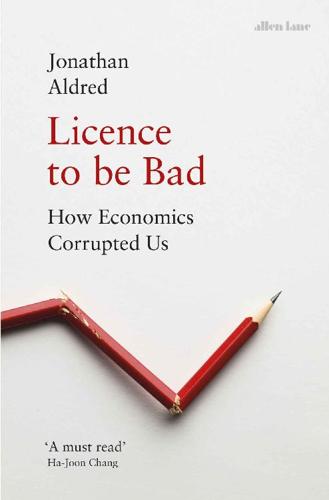
Licence to be Bad
by
Jonathan Aldred
Published 5 Jun 2019
On 5th December 1994, the day John Nash left America for Stockholm to collect his Nobel Prize, Vice-President Gore was announcing the ‘greatest auction ever’ – an auction of airwave frequency spectrum licences to be used by mobile phones. Auctions are a type of game, and this auction was carefully designed using the latest game theory. When the auction closed in March 1995, the US government was delighted: it had received more than $7 billion in bids. The spectrum auctions, great revenue-raising successes for government, were hailed as a triumph of applied game theory. Here, at last, was a setting in which truly ‘rational’ players would interact – big corporations competing in an auction, each advised by a team of game theorists – leading to outcomes which could be predicted and tweaked by the game theorists designing the auction, on behalf of the government.
…
And the final outcome does not suggest hyper-rational corporate players after all. Many successful bidders defaulted on their payments, and the later rise in failures and mergers in the telecoms industry was widely attributed to the burden of excessive auction bids.18 The experience with a British spectrum-licence auction in 2000, also heavily influenced by game theorists, was similar: game theory did not tell the government how best to design the auction, nor did it adequately explain or predict the behaviour of bidders. If game theory has limited use even in situations like these auctions, designed by game theorists as a potentially ideal playground for the theory, then why does it enjoy exalted status in economics today?
…
Coase could barely conceal his contempt for what he saw as this state-diktat approach, pointing out that it was akin to ‘a commission appointed by the federal government [having] the task of selecting those who were to be allowed to publish newspapers and periodicals in each city, town, and village’.5 Coase proposed that slots on the broadcast spectrum should instead be auctioned off to the highest bidder, something then unthinkable to those working in broadcasting. Today, it is standard practice in many countries. Coase’s central argument was that the Federal Communications Commission (FCC) need not procrastinate over the allocation of broadcast spectrum rights.
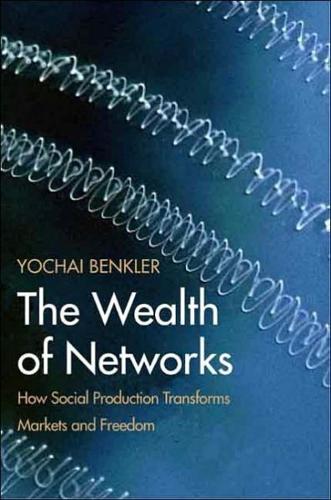
The Wealth of Networks: How Social Production Transforms Markets and Freedom
by
Yochai Benkler
Published 14 May 2006
From 1959, when Ronald Coase first published his critique of this regulatory approach, until the early 1990s, when spectrum auctions began, the terms of the debate over "spectrum policy," or wireless communications regulation, revolved around whether the exclusive right to transmit radio signals in a given geographic area should be granted as a regulatory license or a tradable property right. In the 1990s, with the introduction of auctions, we began to see the adoption of a primitive version of a property-based system through "spectrum auctions." By the early 2000s, this system allowed the new "owners" of these exclusive rights to begin to shift what were initially purely mobile telephony systems to mobile data communications as well. 178 By this time, however, the century-old engineering assumptions that underlay the regulation-versus-property conceptualization of the possibilities open for the institutional framework of wireless communications had been rendered obsolete by new computation and network technologies. 28 The dramatic decline in computation cost and improvements in digital signal processing, network architecture, and antenna systems had fundamentally changed the design space of wireless communications systems.
…
Eli Noam was the first to point out that, even if one did not buy the idea that computationally intensive radios eliminated scarcity, they still rendered spectrum property rights obsolete, and enabled instead a fluid, dynamic, real-time market in spectrum clearance rights. See Eli Noam, "Taking the Next Step Beyond Spectrum Auctions: Open Spectrum Access," Institute of Electrical and Electronics Engineers Communications Magazine 33, no. 12 (1995): 66-73; later elaborated in Eli Noam, "Spectrum Auction: Yesterday's Heresy, Today's Orthodoxy, Tomorrow's Anachronism. Taking the Next Step to Open Spectrum Access," Journal of Law and Economics 41 (1998): 765, 778-780. The argument that equipment markets based on a spectrum commons, or free access to frequencies, could replace the role planned for markets in spectrum property rights with computationally intensive equipment and sophisticated network sharing protocols, and would likely be more efficient even assuming that scarcity persists, was made in Benkler, "Overcoming Agoraphobia."
…
Eli Noam was the first to point out that, even if one did not buy the idea that computationally intensive radios eliminated scarcity, they still rendered spectrum property rights obsolete, and enabled instead a fluid, dynamic, real-time market in spectrum clearance rights. See Eli Noam, "Taking the Next Step Beyond Spectrum Auctions: Open Spectrum Access," Institute of Electrical and Electronics Engineers Communications Magazine 33, no. 12 (1995): 66-73; later elaborated in Eli Noam, "Spectrum Auction: Yesterday's Heresy, Today's Orthodoxy, Tomorrow's Anachronism. Taking the Next Step to Open Spectrum Access," Journal of Law and Economics 41 (1998): 765, 778-780. The argument that equipment markets based on a spectrum commons, or free access to frequencies, could replace the role planned for markets in spectrum property rights with computationally intensive equipment and sophisticated network sharing protocols, and would likely be more efficient even assuming that scarcity persists, was made in Benkler, "Overcoming Agoraphobia."
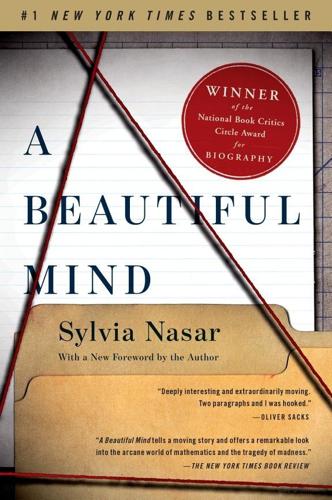
A Beautiful Mind
by
Sylvia Nasar
Published 11 Jun 1998
Coase, “The Federal Communications Commission,” Journal of Law and Economics (October 1959), pp. 1–40, quoted by John McMillan, “Selling Spectrum Rights,” Journal of Economic Perspectives, vol. 8, no. 3 (Summer 1994). 15. Peter C. Cramton, “The PCS Spectrum Auction: An Early Assessment,” The Economist (August 25, 1995). 16. Milgrom, Auction Theory for Privatization, op. cit. 17. Ibid. See also McMillan, “Selling Spectrum Rights,” op. cit., pp. 153–55. 18. Ibid. 19. See, for example, McMillan, “Selling Spectrum Rights,” op. cit.; Paul Milgrom, “Game Theory and Its Use in the PCS Spectrum Auction,” Games ’95, conference, Jerusalem, 9.29.95. 20. Milgrom, Auction Theory for Privatization, op. cit. 21. Ibid. 22. Ibid. 23.
…
Since bidders’ opinions are bound to be wildly divergent, it is possible that license assignment would depend more on bidders’ optimism than on their ability to create a desired service.18 Ideally, an auction design can minimize that problem. As Congress and the FCC inched closer to the notion of auctioning off spectrum rights, Australia and New Zealand both conducted spectrum auctions.19 That they proved to be costly flops and political disasters illustrated that the devil really was in the details. In New Zealand, the government ran a so-called second price auction, and newspapers were full of stories about winners who paid far below their bids. In one case, the high bid was NZ$7 million, the second bid NZ$5,000, and the winner paid the lower price.
…
According to Milgrom, “Game theory played a central role in the analysis of the rules. Ideas of Nash equilibrium, rationalizability, backward induction, and incomplete information, though rarely named explicitly, were the real basis of daily decisions about the details of the auction process.”23 By late spring 1995, Washington had raised more than $10 billion from spectrum auctions. The press and the politicians were ecstatic. Corporate bidders were largely able to protect themselves from predatory bidding and were able to assemble an economically sensible set of licenses. It was, as John McMillan said, “a triumph for game theory.”24 50 Reawakening Princeton, 1995–97 Mathematics is a young man s game.

Model Thinker: What You Need to Know to Make Data Work for You
by
Scott E. Page
Published 27 Nov 2018
Mechanism designers then solve for Nash equilibria and compare institutions based on rational behavior. The framework has proved useful. It can be used to find flaws in existing rules and procedures, to explain why institutions succeed or fail, and to predict outcomes. It has also been used to design a variety of institutions, including the spectrum auctions described in Chapter 2, as well as many online markets, governmental voting systems, and even the procedures that allocate space for projects on space shuttle voyages.1 Our treatment consists of six parts. We first describe the mechanism design framework using the Mount-Reiter diagram. In the second part, we study the problem of three people choosing between two alternatives.
…
Rearranging terms gives r > c(1 + r). 7 See Ledyard, Porter, and Wessen 2000 for a market-based mechanism that produces a better solution to multidimensional payload problems. 8 I borrow the adjective “unreasonable” from physicist Eugene Wigner (1960), who described the mathematical models used in the physical sciences as unreasonably effective. 9 See Ziliak and McCloskey 2008 for a discussion of the ability of social science models to explain variation. 10 See Porter and Smith 2007 for a history on the spectrum auction. 11 See Squicciarini and Voigtländer 2015. See Mokyr 2002 for a full historical account of the importance of knowledge transfer. 12 See www.treasury.gov/initiatives/financial-stability/Pages/default.aspx. 13 For example, during the mid-1990s, about 60% of the restaurants that opened in Columbus, Ohio, failed.
…
Shortcut: How Analogies Reveal Connections, Spark Innovation, and Sell Our Greatest Ideas. New York: Gotham. Poole, Keith T., and Howard Rosenthal. 1984. “A Spatial Model for Legislative Roll Call Analysis.” American Journal of Political Science 29, no. 2: 357–384. Porter, David, and Vernon Smith. 2007. “FCC Spectrum Auction Design: A 12-Year Experiment.” Journal of Law, Economics, and Policy 3, no. 1: 63–80. Powell, Robert. 1991. “Absolute and Relative Gains in International Relations Theory.” American Political Science Review 85, no. 4: 1303–1320. Przeworski, Adam, Jose Antonio Cheibub, Michael E. Alvarez, and Fernando Limongi. 2000.

Markets, State, and People: Economics for Public Policy
by
Diane Coyle
Published 14 Jan 2020
Other Factors Affecting Competition Although competition is generally considered to increase economic welfare, sometimes economic policies deliberately restrict competition. There are various rationales, some good (that is, welfare-enhancing in the sense described earlier in this chapter), some bad (table 2.2). Table 2.2. When Policies Restrict Competition Market power is Deserved Undeserved Concession Competitive, well-designed auction (e.g., spectrum auction, drilling license) Unpaid-for legal monopoly (e.g., tax farming) Intellectual property Major innovation (e.g., patents) Obvious, non-novel innovation (e.g., 70-year post-mortem copyright) Utility regulation Investment in new infrastructure Lucky cost and demand conditions Valid reasons for limiting competition (in other words, reasons likely to enhance economic welfare) are • Protection of intellectual property with a temporary monopoly in the form of a patent or copyright (although this protection can be overly generous—see below)
…
When Policies Restrict Competition Market power is Deserved Undeserved Concession Competitive, well-designed auction (e.g., spectrum auction, drilling license) Unpaid-for legal monopoly (e.g., tax farming) Intellectual property Major innovation (e.g., patents) Obvious, non-novel innovation (e.g., 70-year post-mortem copyright) Utility regulation Investment in new infrastructure Lucky cost and demand conditions Valid reasons for limiting competition (in other words, reasons likely to enhance economic welfare) are • Protection of intellectual property with a temporary monopoly in the form of a patent or copyright (although this protection can be overly generous—see below). • Concessions or licenses when there is a natural monopoly, preferably awarded by a well-designed competitive auction (for instance, for oil exploration, a rail franchise, or access to radio spectrum). An auction amounts to a competition for the market. • Utility regulation, as an incentive/reward for investment and universal service provision in the case of essential natural monopoly sectors, such as electricity. At times, though, there have been many examples of government-awarded limitations on competition that do not enhance economic welfare: • Legal monopolies that have not been paid for, but given as a reward to a crony (such as tax farming)—historically common but now vanishingly rare in the rich economies
…
The platforms use both the improved physical technology of broadband, GPS, and smartphones and the improved intellectual technology of market design models encoded in their algorithms. Market design is a thriving area of economic research, which has found applications ranging from government bond auctions or spectrum auctions to transport planning and matching donor kidneys to recipients (box 2.9). For all the controversy associated with the prominent big platforms, the potential improvement in economic efficiency from these technologies—smartphones, pervasive broadband, and algorithms—could be significant. Box 2.9.
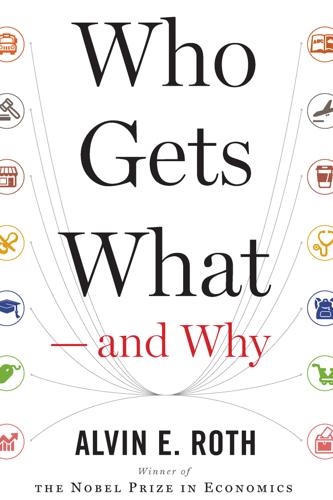
Who Gets What — and Why: The New Economics of Matchmaking and Market Design
by
Alvin E. Roth
Published 1 Jun 2015
Bidders reluctant to share their intentions would want to wait until near the end of the auction before bidding, as we saw in chapter 7 when we considered sniping in eBay auctions. But if everyone waited, the information needed to produce an efficient allocation wouldn’t be transmitted. To avoid this, the design for the spectrum auction included activity rules, proposed by my colleagues Paul Milgrom and Bob Wilson, to prevent bidders from making late bids unless they had made bids on equivalent numbers of licenses (measured in terms of population served) earlier in the auction. Thus big bidders had to make their bids known early, and all bidders could adjust their bids in light of the competition.
…
And it’s not just your behavior online. The map software on your smartphone knows not only where you are but where you’re going. Even your cell phone company has to know where you are whenever your phone is turned on, in order to be able to route calls to you, using the local radio spectrum license it bought at auction for that purpose. So it might be, as all this new technology impinges on our privacy, that we’ll want legal restrictions on some kinds of transactions involving our private data. Property rights—who owns what, and what they can do with it—are an important part of market design, and I predict that we’ll be seeing some new efforts to define the property rights to our transaction data.
…
See also payment systems in auctions, 181–89 discovery of, 185–89 school choice systems and, 151 speed-based competition vs., 85–88 unfair, consumer perception of, 25 privacy, 119–22, 191–92 Prohibition, 197–98, 213 property rights, 192, 222 protected transactions, 198 Protestant Ethic and the Spirit of Capitalism, The (Weber), 200–201 radio spectrum license auctions, 185–89 real estate markets, 111 easy vs. hard matches in, 47–48 packages in, 186 real estate brokers in, 224–25 Redfin, 225 Rees, Michael, 29–31, 32, 39, 44–46, 49, 147–48 regulation, 222–23 central planning and, 7, 149–50, 166–67 of financial markets, 85 free markets and, 226–28 of legal vs. illegal markets, 207 Oklahoma Land Rush and, 57–59 repugnant markets and, 11–12 of restaurants, 220–22 of unraveling markets, 68 reliability, 116, 118–19 religious freedom, 198 repugnant markets, 6, 11–12, 192, 195–215 banning vs. controlling, 212–15 definition of, 196 demand vs. supply and, 205–7 disgust compared with, 196–97 for horsemeat, 195–97 kidney transplants and, 205–12 legal, 197–98, 208–9 market design and, 205–7 in marriage, 198–99 organ sales as, 6, 12, 46 slavery as, 199–200 technology in creating, 201–2 time and place sensitivity of, 196–97, 198–201, 204–5 reputations, 115–16.

Radical Uncertainty: Decision-Making for an Unknowable Future
by
Mervyn King
and
John Kay
Published 5 Mar 2020
When Barclays’ share price fell as their shareholders became nervous, RBS won the bidding contest, and suffered the winner’s curse and failed in 2008. 17 Perhaps the best-known application of auction theory was in the spectrum auctions, in which the US and European governments derived extraordinarily large amounts of revenue from selling bandwidth to competing mobile phone operators. By this time, a generation of graduate students had developed complex variants on the core models. But disproportionate attention has been devoted to such model elaboration in artificial small worlds rather than to empirical study of how these processes work in actual large worlds. Paul Klemperer, who was involved in the design of spectrum auctions for mobile networks in Britain and other countries, observed that ‘what really matters in auction design . . . is mostly good elementary economics.
…
J., 198 , 201 , 203–4 , 206 , 217 Singell, Larry, 74 , 78 Slaughter, Anne-Marie, 214 Sloan, Alfred, 286–7 , 412 small world models: Arrow–Debreu world, 343–5 ; and behavioural economics experiments, 116 , 141–7 ; and classical statistics, 247 ; and engineering, 352–6 ; and framing of problems, 261 , 362 , 398–400 ; and legal reasoning, 203 , 204 ; and machine intelligence, 173–7 , 185 , 263 ; of Malthus and Jevons, 358–62 ; maps as not the territory, 391–4 ; and narratives, 249–61 , 303–4 , 307–10 , 320–1 , 346 , 385 , 397 ; and non-human species, 274 ; as not ‘the world as it really is’, 96 , 100 , 252–5 , 261 , 309–10 , 320 , 342–5 , 346–51 , 352–5 , 376 , 399–400 ; and optimising behaviour, 112–13 , 116 , 129 – 30 , 155 , 166 , 170 , 334 , 382 , 399–400 ; and policy making, 346–9 ; and risk in finance theory, 421 ; and Savage’s analysis, 112–14 , 249 , 309–10 , 345 ; and styles of reasoning, 137–9 smartphones, 30–1 , 344 Smets, Philippe, 78–9 Smith, Adam, 163 , 254 , 343 , 382 , 387 ; The Wealth of Nations , 172 , 190 , 191 , 249 , 253 Smith, Ed, 263–4 Smith, John Maynard, 158 Snow, Dr John, 283 social choice theory, 440 social insurance, 161 , 192 , 427 social media, 351 social relationships: and altruism, 157 , 158 , 159–60 ; cooperation/collective intelligence, 155 , 162 , 176 , 231 , 272–7 , 279–82 , 343 , 412 , 413–17 , 432 ; economic advantages of cooperating, 159 , 160–1 ; and entrepreneurship, 431–2 ; and evolutionary science, 156–65 , 401 ; human capacity for communication/language, 159 , 161 , 162 , 172–3 , 216 , 272–7 , 408 ; mutualisation of risk, 160 , 162 , 192 , 325–6 ; networks of trust/cooperation/coordination, 17 , 155 , 272 , 274–6 , 432 ; process of forming expectations, 350–1 ; reciprocity in, 190–2 , 328 ; round of drinks phenomenon, 189–90 ; social class structure, 324 ; social kinship groups, 156 , 159–62 , 215–16 , 325 , 328–9 , 413–14 ; and trust, 162–3 , 165 social welfare, xiv–xv , 41 Socratic dialogue, 162 Solomon, King, 196 Solow, Robert, 42 Sony, 28 Soros, George, 36 , 319–20 , 336 South Korea, chaebol of, 276 South Sea bubble, 315 Soviet Union, 276 , 279 , 280 , 281 Spanish flu, 57 spectrum auctions, 257 Spence, Michael, 254 Spencer, Herbert, 157–8 Sperber, Dan, 162 , 272 , 415 St Athanasius, 99 St Francis, 116 , 127 , 130 , 167 Stalin, Joseph, 25 , 219 , 292 standard deviation, 234 Stanford, Leland, 48–9 , 427 Stanford University, 49 stationarity (mathematical/statistical term): as assumed in modelling, 333 , 339 , 340–1 , 349 , 350 , 366–7 , 371–2 , 382 ; and astronomical laws, 70 ; China and Japan’s turn inwards, 419–20 , 430 ; economics as ‘non-stationary’, 16 , 35–6 , 45–6 , 102 , 236 , 339–41 , 349 , 350 , 394–6 ; and the environment, 362 ; evolution as ‘non-stationary’, 407 , 428–9 , 430–1 ; financial sector as non-stationary, 16 , 202–3 , 268–9 , 320–1 , 331 , 333 , 339 , 366–8 , 402–3 , 406 ; and frequency distribution, 58 , 69–70 , 87 , 202 , 247 , 327 ; ‘Goodhart’s Law’, 36 ; and insurance underwriting, 327 ; and mortality tables, 57 , 69 ; and natural phenomena, 39 ; and opinion pollsters’ models, 242 ; and planetary motion, 18–19 , 35 , 373–4 , 392 , 394 ; and progress in science, 429–31 ; and reflexivity, 36 , 394 ; and resolvable uncertainties, 37 ; and risk-averse individuals, 306 ; and scientific reasoning, 18–19 , 35 , 236 , 373–4 , 388 , 392 , 429–31 ; and Value at risk models (VaR), 366–8 statistical discrimination, 207–9 , 415 statistics, xiii , xvi ; 25 standard deviation events, 6 , 68 , 235 , 331 , 366 ; bell-shaped ‘normal’ distribution, 57–8 , 233–5 , 237 ; classical statisticians, 58 , 247 ; false stories and bogus statistics, 242–6 ; frequency distribution, 38 , 40 , 57–8 , 69–70 , 72 , 86 , 87 , 202 , 247 ; lognormal distribution, 237 , 238 ; measures of central tendency , 237 ; models ignoring radical uncertainty, 15–16 ; opinion pollsters’ models, 240–2 , 390 ; power laws, 236–9 ; quota sampling, 240–1 ; random sampling, 234 , 239–41 ; ‘randomised controlled trials’ (RCTs), 243–5 ; regression analysis, 351 ; ‘scale invariance’, 238 ; standard deviation, 234 ; statistical distributions, 232–6 ; tails of ‘normal’ distribution, 14 , 40 , 166 , 233 , 234–5 , 401 ; see also probabilistic reasoning; subjective probabilities Stewkley church, 376 Stiglitz, Joseph, 254 Stockdale, Admiral James, 167–8 , 330 stomach ulcers, 284 Stoppard, Tom, Travesties , 89 strategy weekends, 180–3 , 194 , 296 , 407 string theory, 219 , 357 STS-119 space shuttle, 374 subjective probabilities: and 9 /11 terror attacks, 74–6 , 202 ; Appiah’s ‘cognitive angels’, 117–18 ; and belief in emerging scientific truth, 100 ; and Chicago School, 73–4 , 342–3 ; definition of term, 72 ; details of problem specification, 76–8 ; Ellsberg’s ‘ambiguity aversion’, 135 ; expected utility , 111–14 , 115–18 , 124–5 , 127 , 128–30 , 135 , 400 , 435–44 ; and extension of probabilistic reasoning, 71–2 ; Keynes and Knight, 72 ; and linguistic ambiguity, 98 , 100 ; and narrative complexity, 218–19 ; ‘pignistic probability’, 78–84 , 438 ; Ramsey describes, 73 ; ‘rational expectations theory, 342–5 , 346–50 ; small world-large world distinctions, 112–14 , 116 , 129–30 , 137–9 , 141–7 , 155 , 166 , 170 , 171 , 173–7 , 382 , 400 ; see also small world models; triumph over radical uncertainty, 15–16 , 20 , 72–84 , 110–14 ; two-child problem, 76–8 , 81 , 98 , 139 ; see also axiomatic rationality ‘sudden infant death syndrome’ (SIDS), 197–8 , 200–1 , 202 , 204 Suez crisis (1956), 174 Sumerians, 39 Survation, 242 Suter, Johann, 427 Sutter, John, 48–9 Swiss Re, 325–6 Switzerland, 418–19 , 426 , 428 Syrian conflict, 99 , 428 Tacoma Narrows Bridge collapse (1940), 33 , 341 Taleb, Nassim Nicholas, 14 , 38–9 , 166 , 422 , 438–9 Tay Bridge disaster (1879), 33 , 341 technological advances, 161 , 258 , 275–6 , 315 , 329 , 362 , 373–4 ; America’s innovative hegemony in, 427–8 ; and evolutionary science, 429 , 430 , 431 Tehran embassy siege (1979), 8 terrorism, 7 , 74–6 , 202 , 220 , 230 , 296 Tetlock, Philip, 21–2 , 221–2 , 294–5 Thaler, Richard, 118 , 148 Thales of Miletus, 303–4 , 319 , 320 , 422 Thames embankments, London, 424–5 Thatcher, Margaret, 290–2 , 412 Theranos, 228–9 Thiel, Peter, 361–2 , 427 The Third Man (film, 1949), 418–19 Thompson, Warren, 359 Thorp, Edward, 38 , 83 Tinbergen, Jan, 134 , 341 , 346 Tolkien, J.
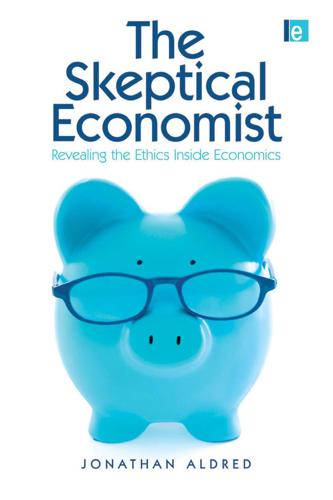
The Skeptical Economist: Revealing the Ethics Inside Economics
by
Jonathan Aldred
Published 1 Jan 2009
In these fields, economic theory has been applied fairly directly to yield useful insights and policy recommendations, without generating difficult ethical dilemmas. Indeed, the influence of economics goes further: in some cases, economists have not just given advice, but devised the entire framework in which economic activity takes place. The mobile phone spectrum auctions and specially designed carbon trading markets only exist because economists invented them. So it is hardly surprising that economics works well in these contexts.3 They are selfcontained closed systems in which the decision makers involved have the time, ability and financial incentives to act like Homo economicus.
…
Land Economics 73: 492-507 Index ability to pay 87 absolute consumption 58-59 accountability 199, 205-206, 230 see also audit culture adaptation 23-24, 25, 237 and increasing happiness 66-67, 98, 140-141 to economic growth 55-57, 61-62 addictive consumption 22-24, 98 advertising brand recognition 16 consumer sovereignty 19-21 increased choice 41 restricting 236-237 affluenza 3, 235-238 altruism see unselfish behaviour animal lives 160 Aristotle 134, 135 audit culture 192-198, 202, 204-205 availability 15-16, 122 babies, markets in 181, 209 Baumol’s cost disease 68-74, 78, 237-238 affordability of personal services 74-77, 191 Baumol, William 68, 75, 76, 77 Bayesianism 164-166, 178, 224-225 Bayes, Thomas 164 Becker, Gary 27, 34 behavioural economics 26, 232-233, 234 belief 13 benefit transfer 157 Bentham, Jeremy 120-121, 130-131, 135 best practice 201, 202 Bewley, Truman 229 biodiversity 160 black box economics 1-2, 4 Blanchard, Oliver 48 Blinder, Alan 232 blood donation 33, 197, 217 body shape and weight 42 brand recognition 16, 21 Breyer, Stephen 156 Broome, John 154 Bush, George W. administration 146, 153, 156 capital investment 168 capital punishment 215-216 Caplan, Bryan 226-227 carbon trading markets 222, 223 cars advertising 20 ownership 42-43, 63 catastrophe, precautionary principle 173 charitable giving 27, 28, 33-34 choice 25-26 costs to consumers 39, 191 economic analysis 12-14, 25-26, 43-44 increasing options 39-43, 182-184, 192 inequalities of 43, 189-190, 209-210 ofjobs 101-102 psychologist analysis 14-19 in public services 184-186, 188-192, 205 rational 11-12, 21, 28, 164-165 see also decision making choice advisers 191 citizen’s income 97 citizens’ juries 214, 215 climate change 2, 21, 146, 147-151, 159, 218 precautionary principle 173 valuing the future 161, 162 commodification 179-181, 206-216 alternatives to CBA 213-216 limits to monetary valuation 216-219 meaning of monetary valuation 207-210 rational decision making 211-213 commuters 56, 57 compensation argument for rates of pay 99-103, 105 competitive consumption 24-25, 57-62, 62-63 congestion 60-61 consumers 11-45 addictive consumption 22-24, 98 choice in public services 182-192 competitive consumption 24-25, 57-62, 62-63 preference satisfaction 37-43 rational choice 11-12 self-interest 26-36 shopping 12-19 sovereignty myth 19-22, 25, 156, 158, 225 consumption future 168 see also consumers context-specific valuation of risk 157-158 contingent valuation surveys 152, 157 contracts 203-204 contribution argument for rates of pay 103-108 coordination problem 63 cost-benefit analysis (CBA) 145-178 alternatives to 173-174, 213-216 best practice 201, 202 climate change 2, 146, 147-151, 159 determining preferences 39 of emotions 30-31 limits to monetary quantification 175-178 valuing the future 161-173 valuing human life 147-148, 151-160, 209 valuing nature 160-161 Coyle, Diane 2 cream-skimming 189-190, 210 cultural differences in perception of happiness 118-120 cultural value 207 Damasio, Antonio 44 decision making 174, 175, 176-177, 211-214 see also cost-benefit analysis (CBA) declining discount rates 169-170 democracy and accountability 199, 206, 230 and CBA 172-173, 176-177, 214 economics as 225, 227-228 valuing life 158-159 see also politics deserving what we earn 99-109 desire 13 Dickens, Charles 138 digital TV 41, 42 diminishing marginal utility 95, 158-159 disappointment 41 discounting 149, 166-173, 176, 178, 226, 234 doctors 2, 70, 91, 106-107 decisions on behalf of patients 186-187 drugs 128 earnings 79-80 differences in 99-109 personal services sector 70-71 see also performance-related pay (PRP); taxation economic growth 47-78, 168, 170 adaptation to 55-57, 61-62 affordability of personal services 74-77 alternative form of 236-238 and consumer sovereignty 21-22 and happiness 48-55, 61-62, 66-68, 141-142 meaning and measurement of 64-66 rivalry 57-62, 62-63 self-help 62-64 and taxation 88, 89 and work 235-236 see also Baumol’s cost disease economic imperialism 180, 222-223, 233 ecosystem services 160-161 education as a positional good 60-61, 190 reflected in pay 100, 105, 106 to enable pursuit of a good life 136, 236 education services 69, 237-238 choices 185-186 goals 202 inequality 189 supply and demand 190 efficiency 4-6, 8, 177 personal services 75, 191 taxation 93, 94, 95-98, 111-112, 237 effort 108 Ellsberg Paradox 164-165 emotions and choosing public services 185 and complex choices 40-41, 42 and monetary incentives 197 and prediction of satisfaction 16 and self-interest 30-31 employment 48, 53, 142, 235-236 Environmental Protection Agency (US) (EPA) 151 ethics 7-9, 224-228, 239 consumers 34-36, 37-38, 44 desert 108 and efficiency 5-6, 112 impartiality across generations 166-167, 171-172 limits to monetary valuation 216-219 monetary value for human life 150, 159-160 personal 138 principled disagreement 201-202 for public policy 133-139, 140-141, 142, 177, 234 view of discount rates 170-171 Experience Machine 127 Experience Sampling Method 123,124 fairness and efficiency 94-98 framing effects 14-15, 16, 18, 197 Frank, Robert 56 Freakonomics 1, 31-32, 34, 233 free trade 5-6 Friedman, Milton 7 future generations, discounting 166-167, 168-169, 171-172 future outcomes discounting 149, 166-173 precautionary principle 173-174 see also probabilities gambling games 164 game theory 222, 233 goals happiness 125, 126, 129-133 monetary incentives 200-201 for public services 199, 201-202 self interest 17, 37 Goodhart’s Law 141, 192, 194, 202, 223-224 governments auditing public services 203-204 consumer sovereignty 30, 38, 186 economic growth 47-48, 49, 68 Greatest Happiness principle 137-138 policy and CBA 150, 154, 157, 160, 172-173, 175, 215-216 policy for maximizing happiness 141-143 rights of ownership 81-82, 84-85 setting priorities 210 trust in 230-231 Greatest Happiness principle 127-133, 136-138 growth paths 65, 66 guilt 27, 28, 30-31 habitat destruction 160 Hahn, Robert 163 happiness 113-143 adaptation to material improvement 55-57 defining 114-116, 120-121, 134 and economic growth 48-55, 61-62, 66-68 maximized through extending choice 183 maximized through pay incentives 109 maximized through taxation 94-98 measurement of 53-54, 116-126, 139-140, 141, 224 philosophy of 126-133 and public ethics 133-139 as public policy 140-143 of service providers 191 happiness economics 50-55, 64, 78, 115, 122 alternative form of economic growth 236-237 and politics 137-138, 141-143 happiness treadmill 23, 24, 55 see also satisfaction treadmill Harrod, Sir Roy 59 Hayeck, Friedrich von 27-28 health insurance (US) 189-190 health services 69, 71-72, 237-238 difficulty in choosing 184-185 inequality in 189-190 productivity improvements 70, 74 see also doctors Heckman, James 188 higher pleasures 130-131, 135-136 Hirsch, Fred 59, 63 holiday entitlements 58, 59 holidays 17 Homo economicus 27, 29-36, 44, 111,178 and behavioural economics 232 determining preferences 39 location in brain 225-226 self-fulfilling assumption 224 service providers 187 and trust 230-231 useful context for 222-223 hours of work 91-92, 105, 108 House of Lords (UK) report on climate change 148, 150 human life discounting 168 monetary value of 21, 147-148, 151-160, 207-208 Quality-Adjusted Life Years 176 Hume, David 129 identity 24-25, 42, 154 ignorance 162 incentive to work 89-92, 104, 109 and tax 109-112 see also audit culture; monetary incentives income adaptation to 23-24 and happiness 52-54 relative 57-58, 59-60, 62 see also earnings; taxation income effect 91, 92 income tax see taxation inconspicuous consumption 59 inefficiency see efficiency inequality acceptability of 79-80 and choice in public services 188-190, 209-210 effect on happiness 54 rates of pay 99-109 information for consumers advertising 19-20 complexity in public services 184-185 inheritance 81, 86, 99 genetic 101, 108 in-kind valuations 213—214 intellectual diversity 229 interest rates 167—168, 169 Intergovernmental Panel on Climate Change (IPCC) 147-148, 158 internet 43 interpersonal utility comparisons 49-50 Israeli day-care centres study 32 Japan, economic growth and happiness 52 Jefferson, Thomas 130 Jevons, William Stanley 49 job centre case workers 188, 202 Kahneman, Daniel 25-26, 124 objective happiness 114, 121, 125, 126 Peak-End evaluations 17, 122, 125 Keynes, John Maynard 6, 177, 235 Kyoto Protocol 146, 148 labour costs see Baumol’s cost disease labour market 5, 72, 142 language 87, 239 and reporting happiness 116-117, 118-119 law-breakers 34-35 Layard, Richard 121, 126, 137 alternative form of economic growth 236-237 Greatest Happiness principle 129-130, 132-133 happiness drugs 128 Le Grand, Julian 184, 186, 187, 188-189, 195-198 libertarianism view of taxation 82, 84, 86 widening choice 183, 205 libertarian paternalism 227-228 life expectancy 54 limited edition products 60 Locke, John 84 lost wallets 27, 28, 30 love 27, 208 luck and responsibility 105-106 marginal tax rates 96-97 market imperfections 218 market prices 33, 107 market rates of pay 99 compensation argument 100-101, 102, 103 contribution argument 103, 104, 106-107 putting a value on human life 147-148, 152-155 mental illness 3, 42, 54 Mill, John Stuart 130-131, 135-136, 183 mobile phone spectrum auctions 222 monetary incentives 30, 31-33, 195-198, 217 public services 200-201 see also performance-related pay (PRP) monetary quantification see commodification; cost benefit analysis (CBA) money corrosive effects of 209 see also monetary incentives mood 121-122, 125 moral convictions 217 motivation intrinsic 33, 195, 197, 200-201 public service staff 186-188, 191-198, 199, 200-201, 206 see also self-interest; status seeking national product 64-65, 70 natural talents 99, 101, 102, 105 nature ownership rights 210 putting a value on 160-161, 208, 213-214 neuroscience 50, 115-116, 117-118, 225-226 news media current perceptions of economics 6-7 doctrine of self-interest 34 silence on Baumol’s cost disease 68-69, 77 Nietzche, Friedrich Wilhelm 119 non-economic impacts 7 non-renewable resources 168 Nozick, Robert 127 Nussbaum, Martha 131 objective happiness 114, 121, 125, 126, 127 objective list theories 134-136 optimal tax theory 95-98 optimization 233 options 13-16 increasing 39-43, 182-184, 192 ownership principle 80-87, 218 pay see earnings; performance-related pay (PRP) Peak-End evaluation 17-18, 122, 125-126 perceived happiness 140 perfect preferences 37-39, 43, 135-136 performance-related pay (PRP) 33, 193-194, 195-198, 200, 237 performative contradiction 231 performative economics 223-224 personal services 69-77, 237-238 Peter the plumber 92-93 pleasure 22-23, 130-131, 134, 135 policy entrepreneurs 1-2 political economics 230-231, 233 political forums 214, 215 politics democracy and CBA 172-173, 177, 215 and happiness economics 137-138, 141-143 poll taxes 93-94 positional goods 59-61, 63, 190, 236, 237 post-tax distribution 85—86, 87, 98 precautionary principle 173—174 preferences 13, 14, 135—136, 225 and advertising 19—20 of future generations 168-169 pure time 166-167, 172 revealed by choices 21, 64 risk 156, 159, 176 satisfaction 37-43 pre-tax economic activity 92-93, 94 pre-tax income 80-84 pricelessness 209, 210 principled disagreement 201-202 priorities audit culture 193, 202 government policy 38, 50, 141,142 private property 80-81 probabilities 150, 154, 155, 161-162, 164-166 productivity 65-66 high earners 96-97 personal services 70-72, 73-74, 75-76 and taxation 88, 89, 90 progressive tax systems 96, 97 psychological well-being (PWB) 134-135 psychology 14-19 see also behavioural economics public opinion 214 public perception of risk 153, 155-156 public service ethos 194, 199-201, 205, 210,219 public services 68, 74-75, 180 affordability 74-77, 237-238 and attitudes to taxation 110-111 audit culture 192-198 complexity and importance 184-185 distinctiveness of 198-206, 216-217 ensuring real choice 188-192 implications of choices for others 185-186 motivation of service providers 186-188, 191-198, 199, 200-201, 206 trust 203-206 widening choice 182-184 see also Baumol’s cost disease pure time preference 166-167, 172 qualitative factors 163 Quality-Adjusted Life Years 174 quality of life 3, 236 measurement of 49-50, 50-55 and public ethics 135-139 quantifying the unquantifiable 162-166 targets 193 Ramsey, Frank 167 rational choice 11-12, 21, 28, 164-165 see also decision making Rawls, John 99, 101, 102 redistribution 86, 88, 92-94 maximization of happiness 95-98 Rees, Bill 232 regret 41, 42 relationships, putting a value on 208 relative consumption 58-59, 61 relative income 57-58, 59-60, 62 research objectives and methods 228-230 responsibility 41, 100, 105 rights 82, 83, 181, 210, 218 rigour in research methods 229 risk monetary value of 21, 151-158, 178, 211 versus uncertainty 161-166 rivalry 24-25, 57-62, 62-63, 237 and increasing happiness 66-67, 98 sacrifice 196 satisfaction treadmill 125, 126, 140 see also happiness treadmill scarcity 59-61, 106-107 science and economics 1, 8, 50, 224, 225,227, 228-230 Greatest Happiness principle 131-133 see also neuroscience self-control 18-19 self-help 62-64 self-interest 12, 13, 17-19, 26-36 and consumer sovereignty 21-22 politicians and economists 230-231 public service providers 187, 188 self-fulfilling assumptions of 31-34, 223 self-reported happiness see surveys, happiness Sen, Amartya 132, 136, 234 Shaw, George Bernard 208, 210 shopping 11, 12 addiction and compulsion 22-26 economist perspective 12-14 psychologist perspective 14-19 smiley-face sampling 124, 130 smiling 119-120 Smith, Adam 6 smoking 18-19, 132, 135 spare capacity in public services 190 standard of living 48 state benefits 85-86 statistical lives 151-152, 154, 207-208 status anxiety 24-25 status seeking 58-61, 62-63, 236 Stern Review 148-149, 150, 166 substitution effect 91, 92, 96 subtractive method 117 supply and demand in public services 189, 190 rates of pay 100, 101, 105, 106 surveys 214 contingent valuation 152, 157 happiness 53-54, 114-115, 116-117, 118-124, 130, 137 public services users 182 sustainability 171 sustainable development 173 Sutton, Willie 34 targets see audit culture taxation 76, 79-98 cigarettes 132 effect on work 88-92 evasion 35 incentive to work 109-112 ownership principle 80-87 redistribution 86, 88, 92-94 to maximize happiness 94-98, 237-238 teachers 70 team working 193, 194 technical innovation 65, 70, 73-74 theory and self-fulfillment 223-224 Titmuss, Richard 33 trade-offs 13 complex choices 40-41 economic growth 63-64 life 160, 211 taxation 94, 95, 97 The Truman Show 127 trust 203-206, 230-231 TWA Flight 800 163 ultimatum game 29, 33-34 uncertainty and the precautionary principle 173 and risk 161-166 unselfish behaviour 27-28, 29 reaction to manipulation 31-32 service providers 187-188 utilitarianism 120-121, 126-133, 135,136,138-139, 183 Uttal, William 117 value judgements see ethics value for money 212 veto economics 2-3, 6, 227 Viscusi, Kip 153 volunteers 195 wage differentials 152-153, 157 Weitzman, Martin 169 work and employment 235-236 hours of 91-92, 105, 108 see also incentive to work worker inputs and outputs 104-105 Table of Contents Contents Acknowledgements Chapter One - Introduction: Ethical Economics?

Digital Disconnect: How Capitalism Is Turning the Internet Against Democracy
by
Robert W. McChesney
Published 5 Mar 2013
It’s not that folks are hogging spectrum, they’re warehousing it—mothballing it away so no one else can use it.”94 What exists is a “false scarcity” wherein AT&T and Verizon “continue to gobble up more and more of the spectrum capacity needed to provide wireless service.”95 Matt Wood of Free Press notes that “Verizon and AT&T have insurmountable advantages in the current system of spectrum allocation, which allows them to outbid everyone else—both in FCC spectrum auctions and on the ‘secondary market’ when other licensees look to sell—and then hoard the spectrum they have without really putting it to good use quickly enough.”96 In 2011, one industry trade publication reported that AT&T had license to $10 billion worth of spectrum that was lying fallow, while it lobbied to have more spectrum diverted to it.97 This guarantees that no alternative can emerge.98 In a sane society, policy debates over spectrum would concern how best to utilize this public resource.
…
One Forbes writer reflected the growing concern among businesses that America badly lags behind most advanced nations in broadband speed and prices. “This inferiority is almost purely a result of the lack of true competition and pro-consumer regulation in the telecom industry.”102 The President’s Council of Economic Advisers issued a report in February 2012 calling for more spectrum to be auctioned to improve wireless broadband.103 Later in 2012 a presidential advisory committee, including executives from Microsoft and Google, urged President Obama “to adopt technologies that would use radio spectrum more efficiently.”104 But while some in Washington might wish to see this new spectrum enable a credible challenger to the ISP cartel, the effects would not be felt for five to ten years, and there is no evidence that either political party wants to have a head-on collision with the cartel over what the cartel regards as a matter of life and death: maintaining its vise-like grip on Internet access.
…
The economist Richard Layard thinks it is a highly desirable policy for other nations to adopt. I agree. See Richard Layard, Happiness: Lessons from a New Science (New York: Penguin, 2005), 161. 47. This figure was created by the staff of former FCC commissioner Michael Copps in consultation with various experts and based upon evaluating the amounts raised during recent spectrum auctions. See “Remarks of Commissioner Michael J. Copps,” National Conference on Media Reform, Memphis, TN, Jan. 12, 2007. 48. See McChesney, Communication Revolution, chap. 3. 49. Cited in Lewis Hyde, Common as Air: Revolution, Art, and Ownership (New York: Farrar, Straus & Giroux, 2010), 45. 50.
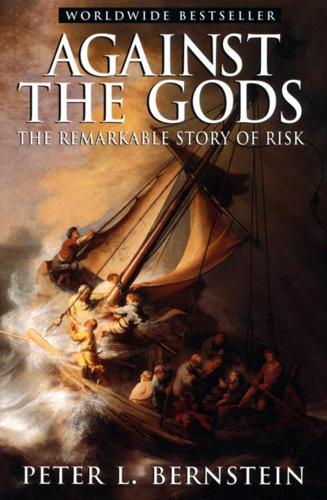
Against the Gods: The Remarkable Story of Risk
by
Peter L. Bernstein
Published 23 Aug 1996
Two licenses would be issued for each of 51 zones around the country; no bidder could acquire more than one license in any zone. The usual procedure in such auctions is to call for sealed bids and to award the contract to the highest bidders. This time, acting on the advice of Paul Milgrom, a Stanford University professor, the FCC chose to conduct the auction according to game theory, calling it a "Spectrum Auction." First, all bids would be open, so that each contestant would always know what all the others were doing. Second, there would be successive rounds of bidding until no contestant wanted to raise its bid any higher. Third, between rounds, contestants could switch their bid from one zone to another or could bid simultaneously for licenses in adjoining zones; since there is an economic advantage in having licenses in adjoining zones, a particular license might be worth more to one party than it would be to another.
…
The highest bidder in an auction of this kind often suffers what is known as the Winner's Curse-overpaying out of a determination to win. The Winner's Curse does not need a fancy auction-the same curse may be visited on an investor in a hurry to buy a stock on which someone has provided a hot tip. To avoid the curse, trading sometimes takes place on computer screens in a manner that closely resembles the spectrum auction. The players-usually large financial institutions like pension funds or mutual funds-are anonymous, but all bids and offers are displayed on the screen together with reservation prices above which the investor will not buy and below which the seller will not sell. In January 1995, the publication Pensions and Investments reported on another application of game theory in making investments.
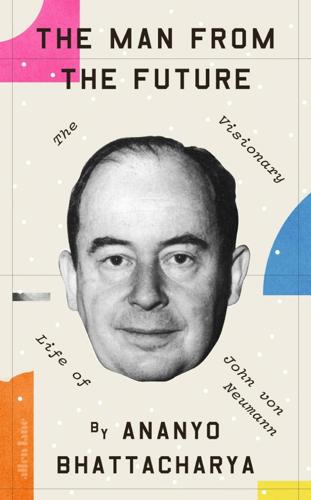
The Man From the Future: The Visionary Life of John Von Neumann
by
Ananyo Bhattacharya
Published 6 Oct 2021
The following year, a new round of auctions for ninety-nine communications licences, hailed by the New York Times as ‘The Greatest Auction Ever’, generated $7 billion. By the end of 1997, insubstantial airwaves had netted a very tangible $20 billion for the US government – more than twice their estimated worth.74 Other countries soon followed the American example. In 2020, just over a quarter of a century after the first US spectrum auctions took place, Milgrom and Wilson would share the Nobel prize themselves. A deluge of Nobels would go to game theorists after Nash, Selten and Harsanyi. Thomas Schelling and Robert Aumann picked up the prize in 2005 for their work on conflict and cooperation. In 2012, the eighty-nine-year-old Shapley, who advanced cooperative game theory, got the call from the Nobel committee – and told them he ‘never, never in my life took a course in economics’.
…
The setup is good for bidders too – they can adjust their bids to collect bundles of licences that complement each other. 74. See e.g. Thomas Hazlett, 2009, ‘U.S. Wireless License Auctions: 1994–2009’, https://www.accc.gov.au/system/files/Hazlett%2C%20Thomas%20%28Auctions%20Paper%29.pdf, and a complete list of FCC auctions here: https://capcp.la.psu.edu/data-and-software/fcc-spectrum-auction-data. 75. Ostrom was the only woman to win the prize until Esther Duflo in 2019. 76. Derek Wall, 2014, The Sustainable Economics of Elinor Ostrom: Commons, Contestation and Craft, Routledge, London. 77. Elinor Ostrom, ‘Design Principles of Robust Property Rights Institutions: What Have We Learned?’
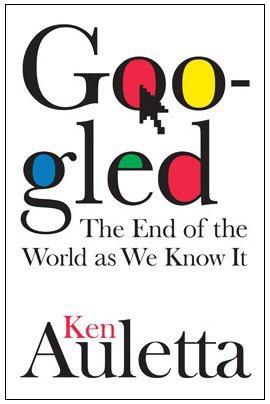
Googled: The End of the World as We Know It
by
Ken Auletta
Published 1 Jan 2009
Ivan Seidenberg, the CEO of Verizon, disputed Google’s contention that his was a closed system: “Since we think we have the most reliable network, we’ll publish standards and let people connect to any device they want to.” The FCC sided with Google, and in July 2007 ruled that the telephone companies could not control what applications were used on this new spectrum. Soon after the FCC announcement, Google raised the stakes by threatening to bid in the January 2008 spectrum auction, establishing itself as a telephone company. Google had no intention of providing telephone service or producing hardware for a Google phone. They would not say this publicly, however, because by fanning speculation—and the speculation was incendiary—they kept people guessing and increased their leverage over the wireless telephone companies.
…
In the auction, that commenced in January, all bidders were instructed not to reveal their bids. When it was over, Verizon and AT&T had won, paying a total of $16.2 billion for two wide swatches of spectrum. In an April “all hands” meeting with Google employees, either attending or on a video hookup, Schmidt confessed, “We had the very good fortune of entering the spectrum auction for $4.6 billion, and not winning. We sweated it out!” Both Verizon and AT&T would pledge to open their networks. AT&T announced that it would sell phones with Google’s Android system, and Verizon announced that it was open to consider any Android prototype. (By the summer of 2009, Verizon had yet to submit an Android application; nor had any phone company, save T-Mobile.)

Algorithms to Live By: The Computer Science of Human Decisions
by
Brian Christian
and
Tom Griffiths
Published 4 Apr 2016
That’s the whole proof.… If I design an algorithm that already optimizes for you, there is nothing you can do.” Algorithmic game theory has made huge contributions to a number of practical applications over the past twenty years: helping us understand packet routing on the Internet, improving FCC spectrum auctions that allocate precious (if invisible) public goods, and enhancing the matching algorithms that pair medical students with hospitals, among others. And this is likely just the beginning of a much larger transformation. “We are just scratching the surface,” says Nisan. “Even in the theory we are just starting to understand it.
…
See also auctions; investment strategies; market behavior bubbles Nash equilibrium and tragedy of commons and Economist Edmonds, Jack educational evaluation Edwards, Ward efficient algorithm efficient or tractable problem, defined Egyptian pharaohs’ reigns electrical memory organ elevator pitch email emotions Engel, Joel Eno, Brian environmental movement epidemiology equality equilibrium Erlang, Agner Krarup Erlang distribution error bars error tradeoff space ethics Evernote eviction policies evolution constraints and expected value Explicit Congestion Notification (ECN) explore/exploit tradeoff Exponential Backoff exponential time (O(2n)) Facebook factorial time (O(n!)) fads false positives FBI FCC spectrum auctions FDA feedback fencing filing Finkel, Larry Firefox fire truck problem First-In, First-Out (FIFO) fitness Fitzgerald, F. Scott Flack, Jessica flash memory flat hierarchies Flood, Merrill flow control food fads minimizing rotten overfitting and Forbes forgetting curve forgiveness Forster, E.
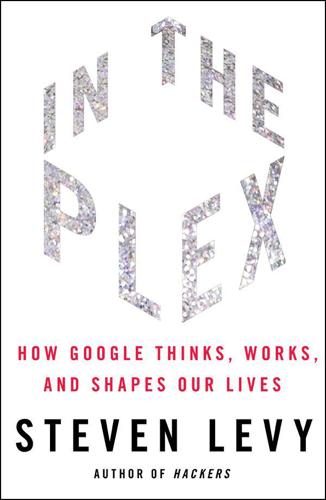
In the Plex: How Google Thinks, Works, and Shapes Our Lives
by
Steven Levy
Published 12 Apr 2011
So the simplification thickens the market. The effect is that it guarantees that there’s competition for the top positions.” Veach and Kamangar’s implementation was so impressive that it changed even Milgrom’s way of thinking. “Once I saw this from Google, I began seeing it everywhere,” he says, citing examples in spectrum auctions, diamond markets, and the competition between Kenyan and Rwandan coffee beans. “I’ve begun to realize that Google somehow or other introduced a level of simplification to ad auctions that was not included before.” And it wasn’t just a theoretical advance. “Google immediately started getting higher prices for advertising than Overture was getting,” he notes.
…
“There’s an 87 percent chance that Verizon will top this.” (Later he explained his reasoning: “There was no way in hell that Verizon was going to let us walk away with spectrum that would destroy its business model.”) The board okayed the bid, and on Thursday, January 24, 2008, Google’s $4.71 billion bid made the spectrum auction official. At that moment Google owned the valuable C block licenses. It still owned them the next day and through the weekend, as no other bidder emerged. “The realization was growing that ‘My God, maybe we were all wrong,’” says Whitt, who was starting to regret his brash 87 percent prediction.
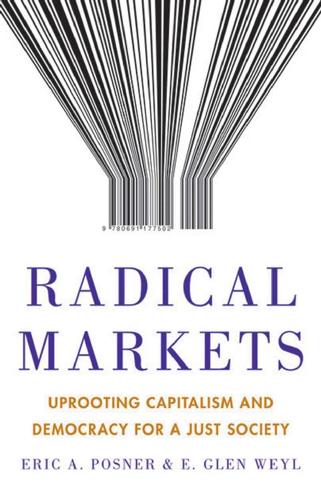
Radical Markets: Uprooting Capitalism and Democracy for a Just Society
by
Eric Posner
and
E. Weyl
Published 14 May 2018
Coase persuaded the Federal Communications Commission (FCC) to auction off the rights to use the broadcast spectrum instead of giving it away or selling it at a price determined by the government.30 In response, economists Robert Wilson, Paul Milgrom, and Preston McAfee developed Vickrey’s work into an auction design to sell off the spectrum.31 But this design only temporarily solved the monopoly problem. Spectrum auctions occurred infrequently and gave winners the chance to hold onto the spectrum for years or even decades at a time. A company that won an auction for a portion of the spectrum years ago might no longer be its highest-valued owner. If a new company would like to buy that portion, its owner may decide to hold out for an excessively high price, which is precisely what has happened, as we discuss below.
…
Rather than sell off these assets permanently or lease them for fixed terms, governments could partially sell them under a license that included a COST-based license fee. The government would start by auctioning off the asset. The winning bidder would self-assess a price and pay a tax on that price. Anyone else could subsequently force a sale of the asset at the stated price. Consider the radio spectrum. Since the early 1990s, long-term spectrum licenses have been auctioned off by governments around the world.58 But the monopoly problem has emerged in secondary markets: the companies that acquired the licenses at auction have been reluctant to sell them to higher-valued users. New uses often require a repackaging of the licenses, creating holdout problems like those that inhibit the building of railroads or shopping malls.
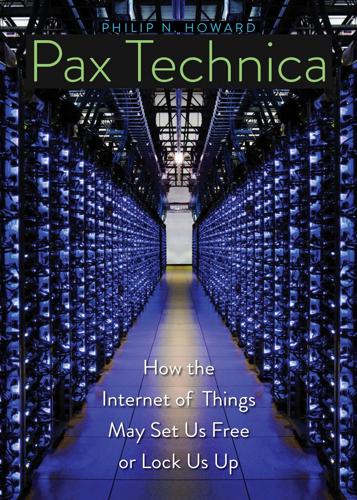
Pax Technica: How the Internet of Things May Set Us Free or Lock Us Up
by
Philip N. Howard
Published 27 Apr 2015
India lost between $8 billion and $20 billion from a badly managed licensing process that benefited corrupt officials and shell companies but left mobile-phone users with worse service, not better. Governments should have open and transparent ways of allocating the public spectrum that encourage ownership diversity. Auctions are straightforward, and special credits for women-owned, minority-owned, and locally owned businesses can increase the diversity of ownership within many sectors that make use of public resources like the broadcast spectrum. When access to the spectrum is publicly auctioned in coordination with programs to improve ownership diversity, the outcome is a transparent process with diverse stakeholders.34 If we buy the argument that a “device tithe” could also go a long way to promoting public access to the internet of things, then perhaps 10 percent of the profits of such auctions should be set aside as a technology fund for public-interest groups.
…
See also Roman Empire pax technica, xix–xx, xxiv–xxv, 297; Chinese internet rivaling, 191; combating the empire of, 184; consequences of, 146; cyberespionage and, 40; defining, 145–47; democracies in, xxii; as empire, 228; evolution of, 34; promise of, 255–57; stability and, xix–xxii, 147, 214, 223, 230; states in, sharing security knowledge, 41–42; threat to, 162; thriving in, 254–55 Pentland, Sandy, 179, 241 People’s Daily (China), 186 People’s Liberation Army Unit 61398, 38–39 periphery, 147 personal identity, 248 Peru, autonomous zones in, 81 Pew Internet and American Life Project, 45 Pfaff, Steve, 110 Philippines: autonomous region in, 81; cybercrime laws in, 165; digital dilemma in, 87; protests in, 127; vigilante groups in, 103–4, 160; working with Anonymous, 43 phone companies, privatization of, 56–57, 74 Piggipedia, 164 piracy, combating, 98 Pirate Bay, 13, 166 Pirate Parties, xx, 166 pirates, 72, 81, 93–94 police, technologies leaking to, 222 political bots, 31, 204–11, 233, 234 political communication, 13 political data, xxi political groups, digital infrastructure and, 135 political information, consumption of, 45 political internet, xiii, 36 political order, 53, 108–10: and relationships between devices, 34; rethinking, 224–25 political power, 16, 233 politics: criminal organizations disrupting, 80; digital engagement with, 9–10; face-to-face contact and, 44; global, 44, 62, 149 Polity IV Project, 92 poor people, global distribution of, 97 Popović, Srđa, 238 Popular Party (Spain), 128 Premise, 142 PRI party (Mexico), 51 privacy groups, 163 privacy violations, 179–80 process tracing, 110 propaganda: bots used for, 205; computational, 29–30; digital media weakening, 124; geotagged, 114–15 prostitution, digital media and, 103 public alert systems, 18–19 public good, 250–51 public opinion, manipulation of, 43 public spectrum, public auctions for, 250 push polling, 209–10, 211 Pussy Riot, 86, 171 Putin, Vladimir, 171, 197, 201 Qtiesh, Anas, 204 Radonski, Henrique, 93 Rassd News Network, 20 reality-based research, 179 Recollections (Tocqueville), 108 Reporters Without Borders, 163 revolutions: histories of, 61; nature of, 108–9 Rheingold, Howard, 85 robocalls, 207 Roh Moo-hyun, 127–28 Rolls-Royce, 212 Roman Empire, 1, 67, 107–8, 146, 231.

Adapt: Why Success Always Starts With Failure
by
Tim Harford
Published 1 Jun 2011
* A bond is a kind of tradable loan: if you buy the bond, you’re getting the right to receive the loan repayments, perhaps from a company, perhaps from a government, or perhaps from some more complex financial process. * Readers of The Undercover Economist may recall Klemperer as one of the designers of the 3G spectrum auctions.
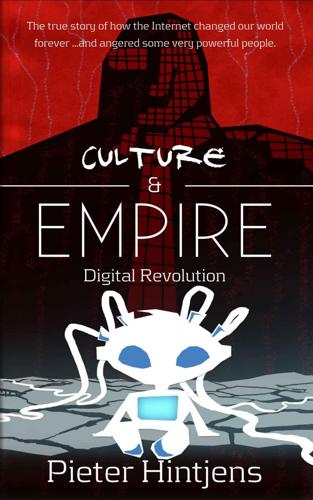
Culture & Empire: Digital Revolution
by
Pieter Hintjens
Published 11 Mar 2013
Before long, multicolored teams of South African engineers were filling Lagos' luxury hotels and planning how to cover the country with mobile phone base stations. I remember the buzz that the teams of young engineers brought to the city in 2001. Things were changing, finally. More or less the same happened across the entire African continent as every country organized its own lucrative spectrum auctions. To build out the mobile phone networks, operators dug cables across every country, criss-crossing it with new, high-capacity fiber. In effect, the First Wave built the wiring that would allow the Second Wave. All it required was some upgrades of the cell towers -- Chinese equipment is really so cheap -- and new handsets.

The Future of Technology
by
Tom Standage
Published 31 Aug 2005
Since 2000 most operators have written down the value of their 3g licences. Some even handed the licences back to the governments from which they bought them, rather than commit themselves to building expensive new 3g networks within strict time limits. (Reselling the licences was forbidden.) The whole episode is now something the industry would rather forget. “The spectrum auction is a nightmare the operators don’t want to remember,” says Mr Cole. “I haven’t heard it mentioned in a long time.” Ready, steady, flop! The pioneering launch of 3g services at the end of 2001 in Japan and South Korea, the world’s two most advanced mobile markets, did little to lighten the mood.
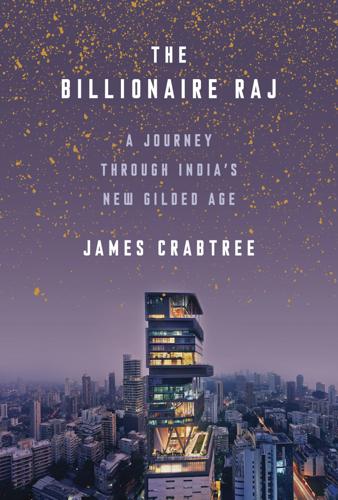
The Billionaire Raj: A Journey Through India's New Gilded Age
by
James Crabtree
Published 2 Jul 2018
“Operationalising Hyper Growth Platforms of New Value Creation for a Prosperous and Inclusive India,” chairman’s statement, 39th annual general meeting post IPO, Reliance Industries Limited, September 1, 2016. 37. “Auction Rigged, Cancel Broadband Spectrum Held by Reliance Jio, CAG Report Says,” Times of India, June 30, 2014. 38. “The Spectrum Auction Was Rigged,” Frontline, September 30, 2016. 39. “Union Compliance Communication,” Report No. 20, Comptroller and Auditor General of India, 2015, ch. 3. 40. See, for instance, “Report of the Comptroller and Auditor General of India for the year ended March 2015,” Comptroller and Auditor General of India, 2016, ch. 14, p. 103. 41.

Smart Mobs: The Next Social Revolution
by
Howard Rheingold
Published 24 Dec 2011
While the answer may be that we should permit a commons to develop alongside proprietary allocations, we will fail to permit that development if we continue to misperceive the choice at hand as one between licensing and exhaustive privatization.83 Benkler used the term “open spectrum” in the summer of 2001, and analyst Kevin Werbach, former counsel for New Technology Policy at the Federal Communications Commission, publicized it in Esther Dyson’s influential Release 1.0, describing the coalition of technologists, academics, and legal activists emerging around the idea of deregulating spectrum.84 The idea is not to do away with auctions but to mix several ways of allocating spectrum and then see which works best. Big players will be able to buy pieces of spectrum at auction, and other large amounts of spectrum will be held as a commons. The regulatory aspects of WiFi are coming under pressure as Moore’s Law reveals itself in the industry: Over the past thirty months, Intel has increased the communication capacity of its WiFi chip by 5,400 percent and dropped the price by 82 percent.85 Sony is planning to put WiFi chips in every TV set and PC it sells in Japan, and Microsoft is planning a launch in the fall of 2003 for Mira, a wireless computer tablet with a WiFi Internet connection built in.

Angrynomics
by
Eric Lonergan
and
Mark Blyth
Published 15 Jun 2020
Because the dominant tech firms – Apple, Amazon, Facebook and Google – are using our collective data as the basic fuel for their profit engines, there is a deal to be struck. In return for access to our data, we can either ask them to pay a royalty, a one-off payment, or we could grant a data “licence” for 30 or 40 years in the same way as the digital spectrum was auctioned to mobile phone companies. This could be done at a national level. One possibility would be to invest the proceeds from this licence fee or royalty in the shares of these companies and pay out an equal dividend to everyone who grants them access to their data. That is not something for nothing.
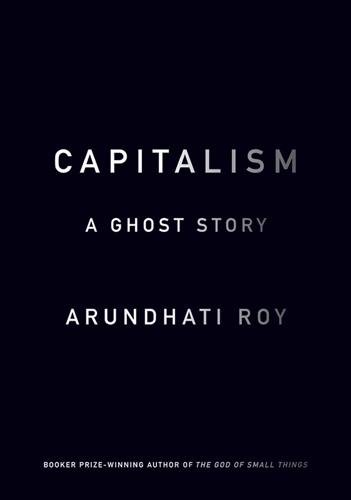
Capitalism: A Ghost Story
by
Arundhati Roy
Published 5 May 2014
Each new corruption scandal that surfaces in India makes the last one look tame. In the summer of 2011 the 2G spectrum scandal broke. We learned that corporations had siphoned away $40 billion of public money by installing a friendly soul as the minister of communications and information who grossly underpriced the licenses for 2G telecom spectrums and illegally auctioned them to his buddies. The taped telephone conversations leaked to the press showed how a network of industrialists and their front companies, ministers, senior journalists, and a TV anchor were involved in facilitating this daylight robbery. The tapes were just an MRI that confirmed a diagnosis that people had made long ago.
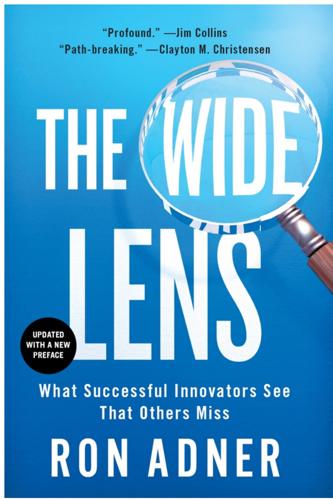
The Wide Lens: What Successful Innovators See That Others Miss
by
Ron Adner
Published 1 Mar 2012
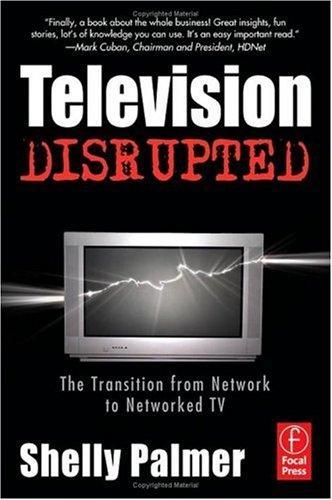
Television disrupted: the transition from network to networked TV
by
Shelly Palmer
Published 14 Apr 2006
All rights reserved. 12-Television.Chap Twelve v3.qxd 3/20/06 7:28 AM Page 184 184 C H A P T E R 1 2 Television Disrupted There is a concerted effort being put forth by consumers, municipalities and commercial enterprises to create a nationwide two-way wireless network capable of transporting data using TCP/IP (Transfer Control Protocol/Internet Protocol), the language of the Internet. The goal of these organizations is to create an environment where all of your wireless devices are connected all of the time. They will use spectrum licensed from the FCC, possibly some of the old analog television spectrum being auctioned off during the analog to digital television transition. As this battle unfolds, you are going to see fierce legal fights between all of the companies that have existing infrastructure and all of the companies and municipalities that want to obviate or disintermediate these old distribution platforms in favor of the new, cheaper, more efficient, inherently two-way wireless systems.
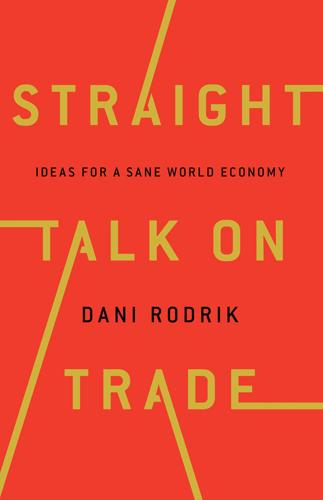
Straight Talk on Trade: Ideas for a Sane World Economy
by
Dani Rodrik
Published 8 Oct 2017
In their book, Leighton and López place special emphasis on political entrepreneurship in making policy reform possible.14 For new ideas to overcome vested interests, they write, it must be the case that “entrepreneurs notice and exploit those loose spots in the structure of ideas, institutions, and incentives.”15 They provide four case studies of this process: spectrum license auctions, airline deregulation, welfare reform, and housing finance. In their words: “[T]he public face of political change may be that of a madman, an intellectual, or an academic scribbler. But whatever form these leaders may take, they are political entrepreneurs—people whose ideas and actions are focused on producing change.”16 As these authors stress, political entrepreneurship can be socially harmful, as when the pursuit of individual rents comes at the expense of overall inefficiency.
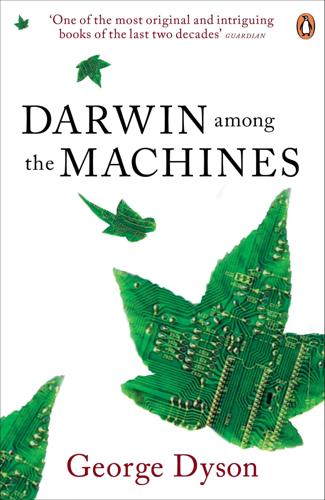
Darwin Among the Machines
by
George Dyson
Published 28 Mar 2012
As everything from taxicabs to telephones to televisions to personal digital assistants becomes connected to the network, universal—and microminiature—wireless is the only way to disentangle the communications web. “But there’s not enough wireless bandwidth to go around,” say the skeptics, citing the billions of dollars raised whenever a few slivers of radio spectrum are auctioned off. Baran disagrees. “Tune a spectrum analyzer across a band of UHF frequencies and you encounter a few strong signals. Most of the band at any instant is primarily silence, or a background of weaker signals . . . much of the radio band is empty much of the time! The frequency shortage is caused by thinking solely in terms of dumb transmitters and dumb receivers.

Flash Crash: A Trading Savant, a Global Manhunt, and the Most Mysterious Market Crash in History
by
Liam Vaughan
Published 11 May 2020
CT, shares in some of America’s most familiar corporations changed hands at prices utterly divorced from anything resembling fair value. Proctor & Gamble, Hewlett-Packard, General Electric, and 3M plummeted 10 percent or more, while the iShares Russell 1000 Value Index, a popular exchange-traded fund, fell from $50 to 0.0001 cents. Accenture sold for a solitary cent. At the other end of the spectrum, Apple and auctioneer Sotheby’s both transacted at $100,000 a share, momentarily pushing their valuations into the trillions of dollars. The stock market’s twilight zone would also prove short-lived. As the e-mini continued its bounce back, participants tentatively returned to equities markets and individual shares began trading again at levels close to where they’d been before 1:30 p.m.
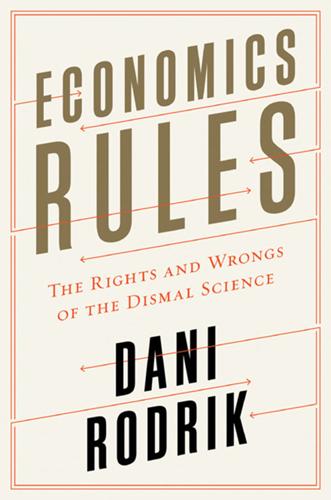
Economics Rules: The Rights and Wrongs of the Dismal Science
by
Dani Rodrik
Published 12 Oct 2015

Dogfight: How Apple and Google Went to War and Started a Revolution
by
Fred Vogelstein
Published 12 Nov 2013
“When I joined the Apple board [in 2006], Steve and I spoke about this [Android], and I said this thing is coming, and we agreed that we would monitor the situation.” Certainly, Google’s other initiatives support Schmidt’s recollection. Android’s success was dependent on its getting the big U.S. carriers to cooperate, but at the end of 2007 Google was, if anything, going out of its way to make them angry. A giant slice of wireless spectrum was up for auction by the government, and Google, with a $4.71 billion bid of its own, tried to drive the price up for wireless carriers. Google didn’t want the spectrum. It just wanted to make sure the government required the winner to play by new, Google-friendly rules. The sanctimoniousness of using money, not to buy spectrum, but to acquire a pulpit from which to lecture carriers on table manners, infuriated them, especially Verizon, the eventual auction winner.

Artificial Intelligence: A Modern Approach
by
Stuart Russell
and
Peter Norvig
Published 14 Jul 2019
Probably the most important things that an auction mechanism can do is encourage a sufficient number of bidders to enter the game and discourage them from engaging in collusion. Collusion is an unfair or illegal agreement by two or more bidders to manipulate prices. It can happen in secret backroom deals or tacitly, within the rules of the mechanism. For example, in 1999, Germany auctioned ten blocks of cellphone spectrum with a simultaneous auction (bids were taken on all ten blocks at the same time), using the rule that any bid must be a minimum of a 10% raise over the previous bid on a block. There were only two credible bidders, and the first, Mannesman, entered the bid of 20 million deutschmark on blocks 1-5 and 18.18 million on blocks 6-10.
…
Both Coase and Ostrom won the Nobel Prize in economics for their work. The revelation principle is due to Myerson (1986), and the revenue equivalence theorem was developed independently by Myerson (1981) and Riley and Samuelson (1981). Two economists, Milgrom (1997) and Klemperer (2002), write about the multibillion-dollar spectrum auctions they were involved in. Mechanism design is used in multiagent planning (Hunsberger and Grosz, 2000; Stone et al., 2009) and scheduling (Rassenti et al., 1982). Varian (1995) gives a brief overview with connections to the computer science literature, and Rosenschein and Zlotkin (1994) present a book-length treatment with applications to distributed AI.
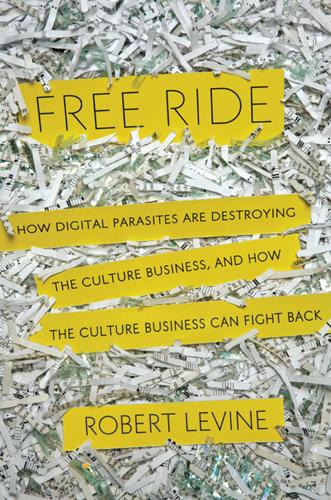
Free Ride
by
Robert Levine
Published 25 Oct 2011

WTF?: What's the Future and Why It's Up to Us
by
Tim O'Reilly
Published 9 Oct 2017
The point is to measure the outcome, and to put any adverse consequences of divergence from the intended outcome on the appropriate parties. Too often, incentives and outcomes are not aligned. For example, government grants mobile phone carriers exclusive licenses to spectrum with the goal of creating reliable and universal access, yet spectrum licenses are auctioned off to the highest bidder. Is this approach giving the right outcome? The quality of mobile services in the United States would suggest otherwise. What if, instead, spectrum licenses were granted based on promises of maximum coverage? Much as Minister Molano Vega did for phone service in Colombia, rebates to customers for failures to live up to coverage promises could potentially create a much more self-regulating system.

System Error: Where Big Tech Went Wrong and How We Can Reboot
by
Rob Reich
,
Mehran Sahami
and
Jeremy M. Weinstein
Published 6 Sep 2021
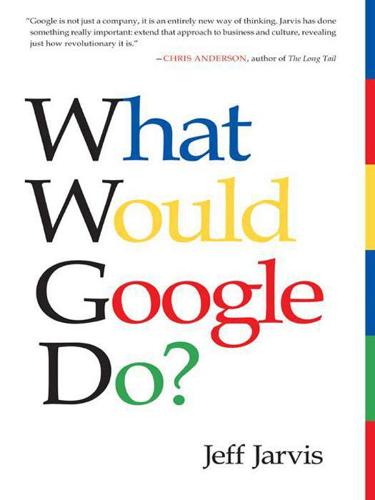
What Would Google Do?
by
Jeff Jarvis
Published 15 Feb 2009

The Zero Marginal Cost Society: The Internet of Things, the Collaborative Commons, and the Eclipse of Capitalism
by
Jeremy Rifkin
Published 31 Mar 2014
Or, in today’s parlance, “the government should not be in the business of picking winners and losers,” not only because it lacks the vital up-to-the-moment information on value propositions that sellers and buyers bring to the market, but also because government policy makers are subject to influence peddling by special interests. Most economists bought into Coase’s thesis, and eventually the FCC itself began to fall in line with Coase’s argument by allocating spectrum leases through public auctions to the highest bidder.51 The FCC’s decision to auction leases wasn’t entirely devoid of self-interest. The government reasoned that from a purely financial perspective, it made far more sense to sell valuable spectrum leases, which could put billions of dollars into the federal coffers, than to just give it away for free.

The Stack: On Software and Sovereignty
by
Benjamin H. Bratton
Published 19 Feb 2016
For its chthonic Cloud, data centers are housed under mountains with reliable ice cores; suburban farmland between metropolitan trading centers is redug to lay private cable for algorithmic trading concerns near the old AT&T switches in New Jersey, realizing a new topographic expression of the transport layer of the TCP/IP stack; while the wireless frequency spectrum is subdivided, auctioned, allocated, and bundled into derivatives like any other prized commercial real estate. Whereas the Schmittian “grounded” way of thinking detests dedifferentiated space and the flattening superimposition of multiple maps, valorizing instead the perspectival spatial order of human establishment, the geographies of The Stack go a long way toward collapsing distinctions between the one and the other, as its interlacing of land, sea, and air through networks of recombinant flows realizes the simultaneous physicalization of the virtual and the virtualization of physical forces.

Politics on the Edge: The Instant #1 Sunday Times Bestseller From the Host of Hit Podcast the Rest Is Politics
by
Rory Stewart
Published 13 Sep 2023
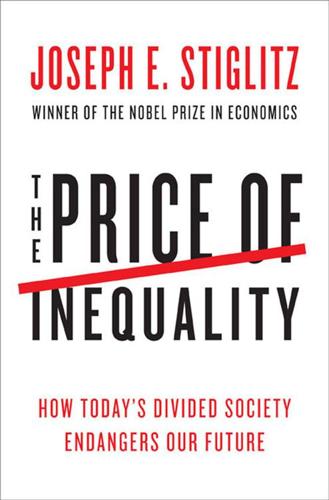
The Price of Inequality: How Today's Divided Society Endangers Our Future
by
Joseph E. Stiglitz
Published 10 Jun 2012

The Rise and Fall of Nations: Forces of Change in the Post-Crisis World
by
Ruchir Sharma
Published 5 Jun 2016
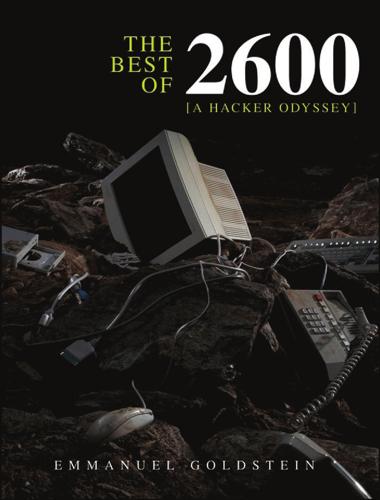
The Best of 2600: A Hacker Odyssey
by
Emmanuel Goldstein
Published 28 Jul 2008
GSM comes to America In the ’90s, the industry began buzzing about Personal Communications Services, or PCS. PCS boasted, among other things, small communications gadgets crammed with neato-keen features to do all sorts of things. Or that’s what they hoped. The FCC allocated the 1900 MHz band of the EM spectrum for PCS, and auctioned off frequencies. (I often wondered if I could purchase that part of the EM spectrum known as “blue,” or maybe “green;” think of the royalties.) Anyway, certain members of the telecommunications industry recognized GSM as a great technology with which to build upon 94192c12.qxd 6/3/08 3:33 PM Page 429 The Changing of the Telephone the PCS idea.